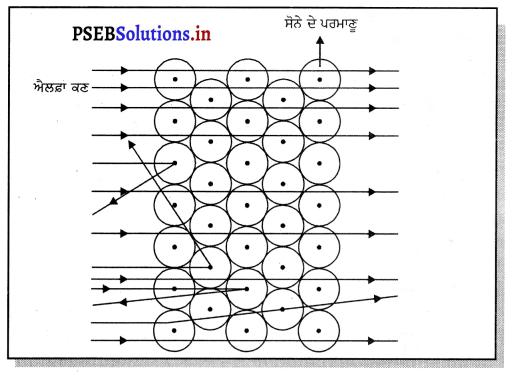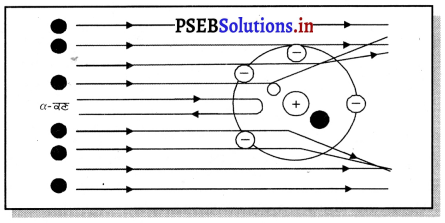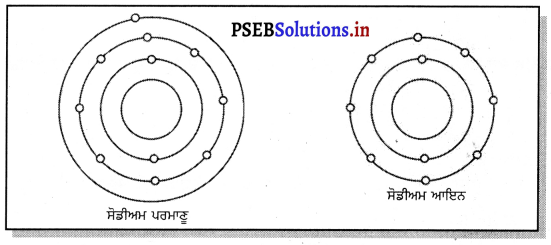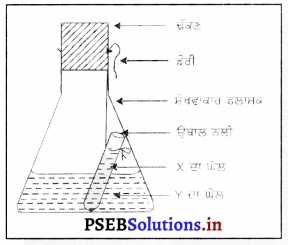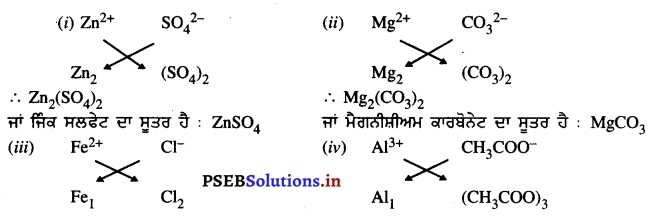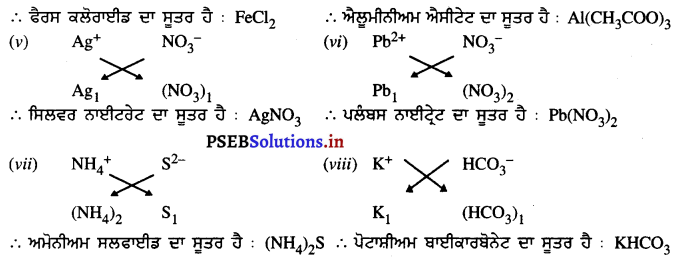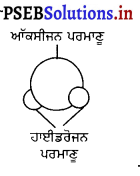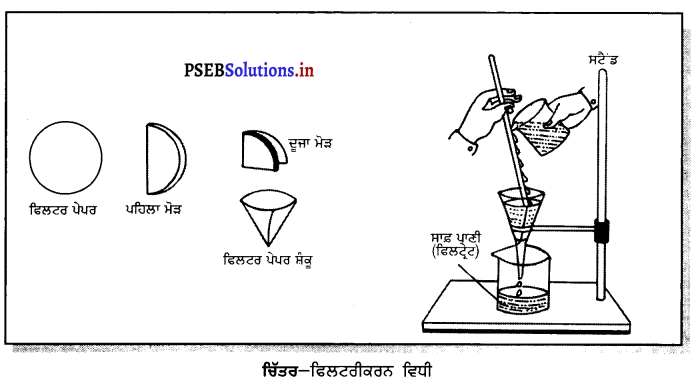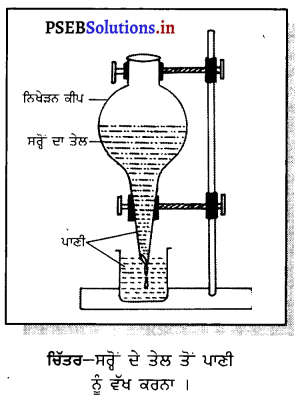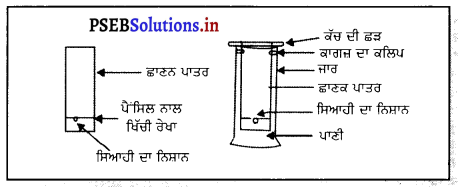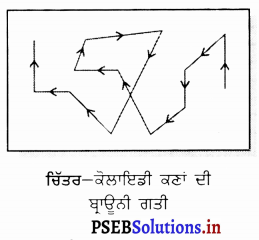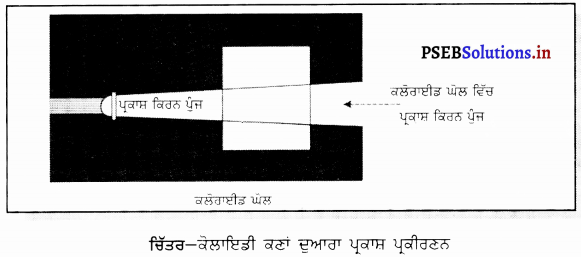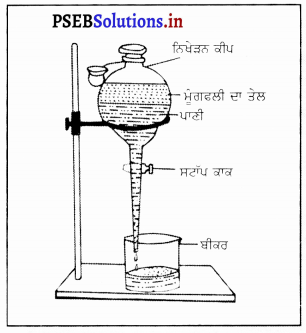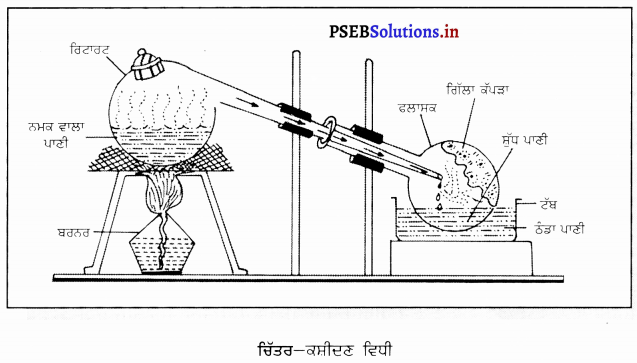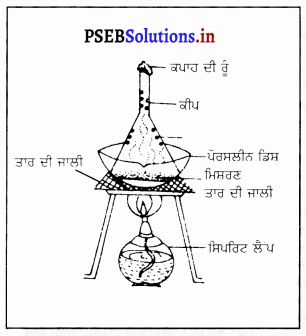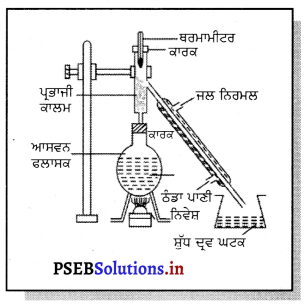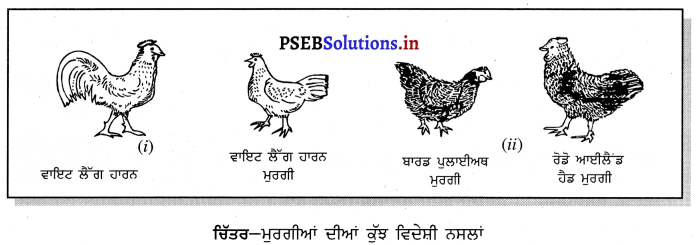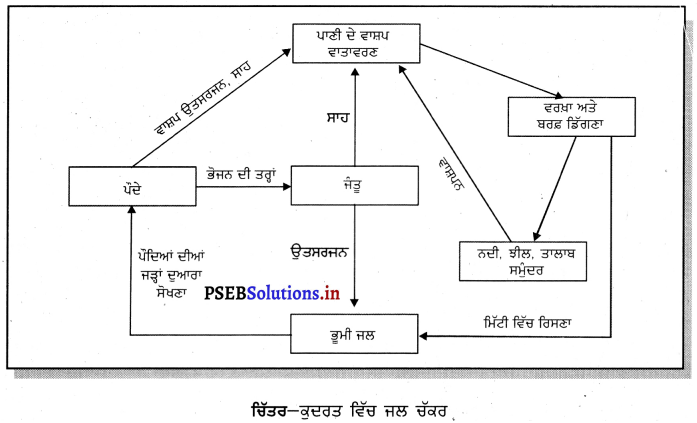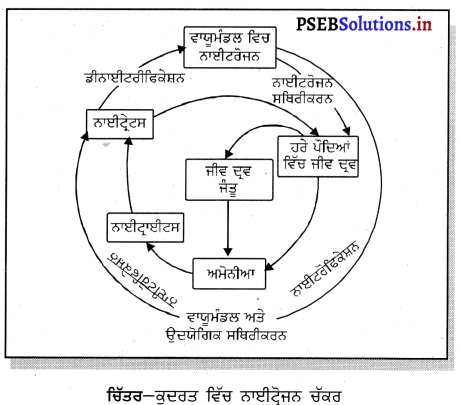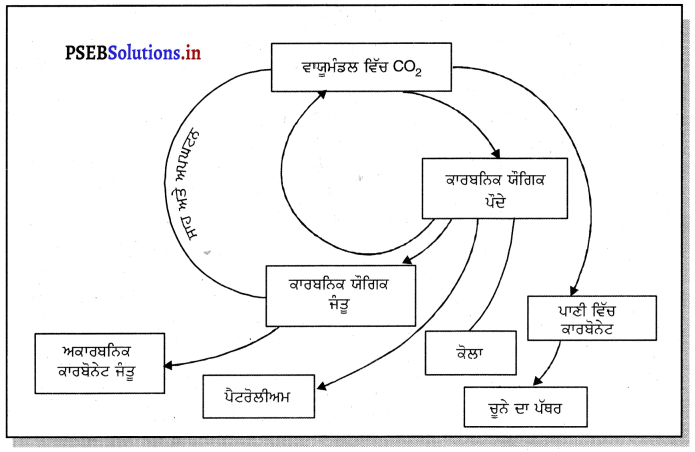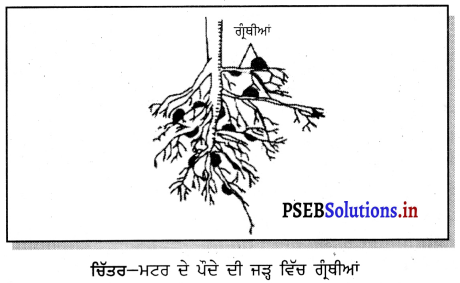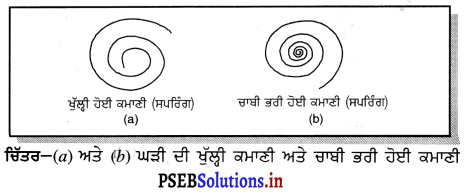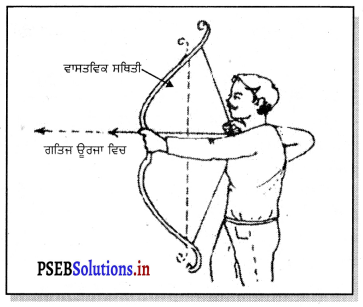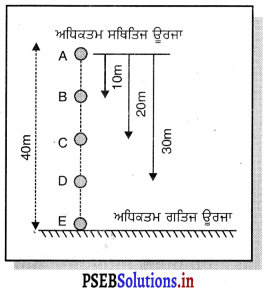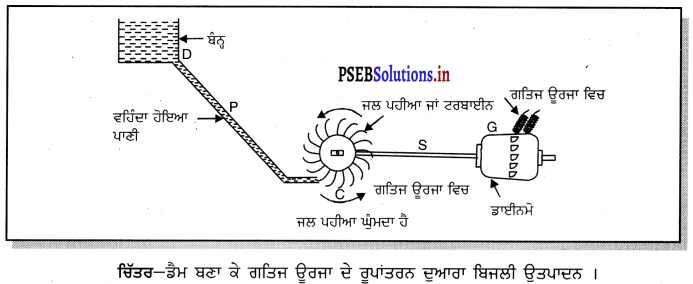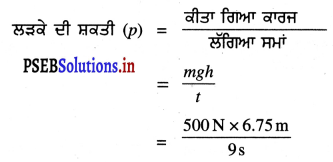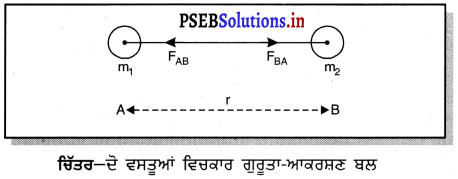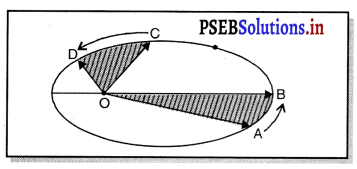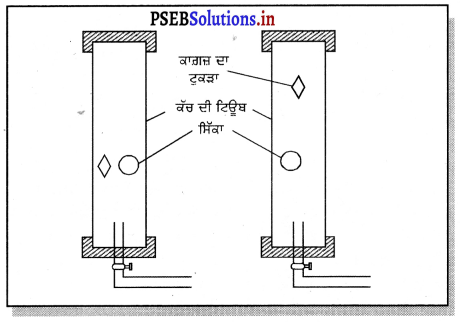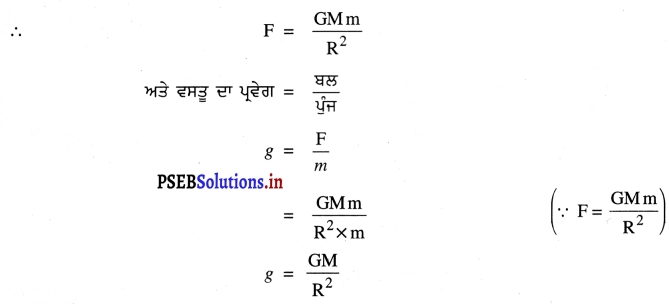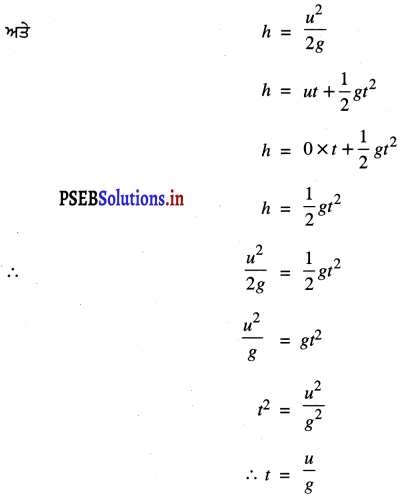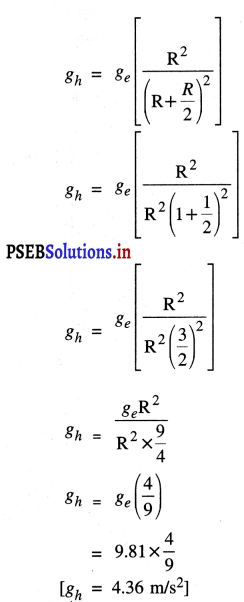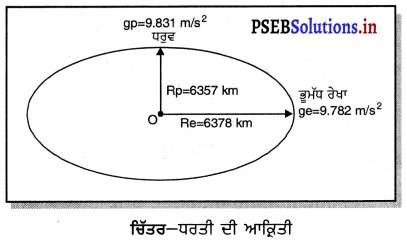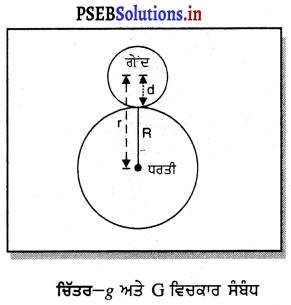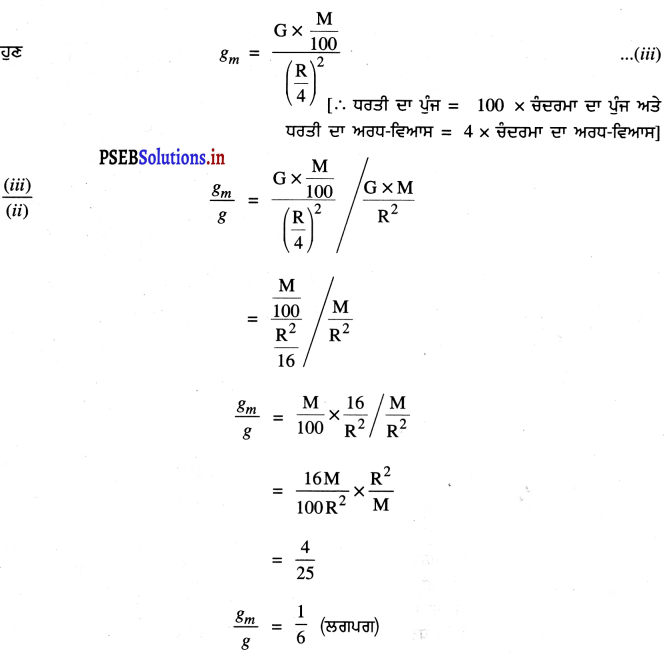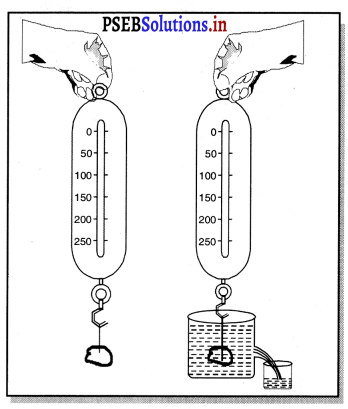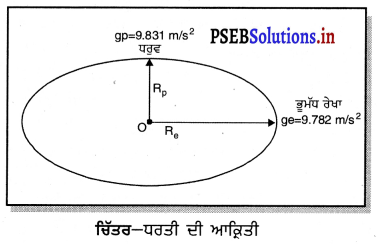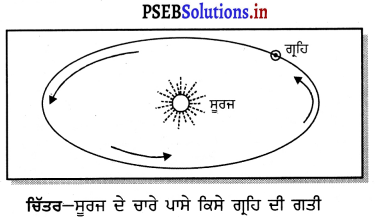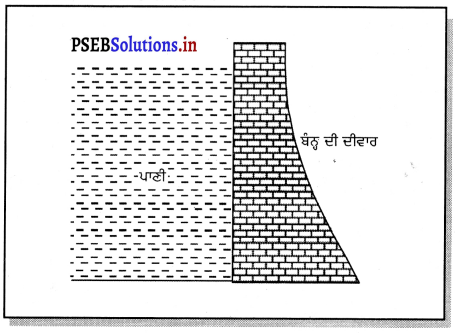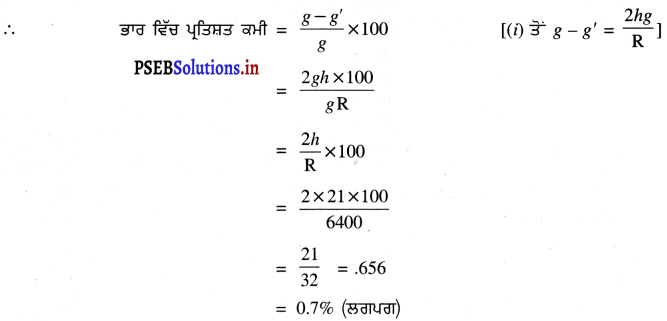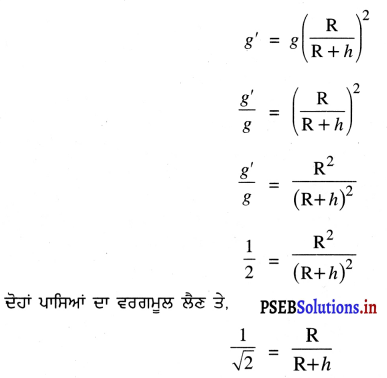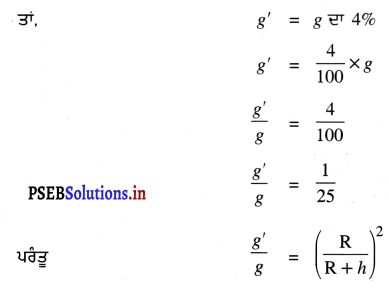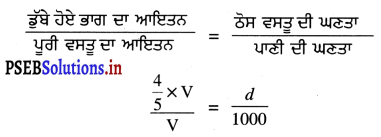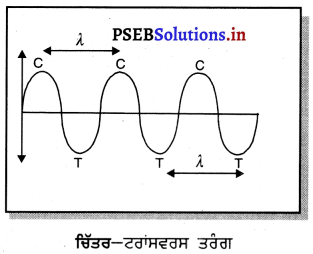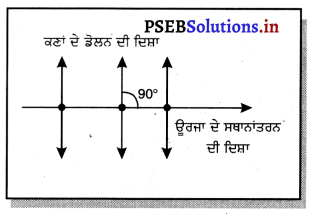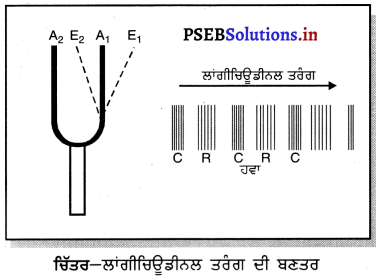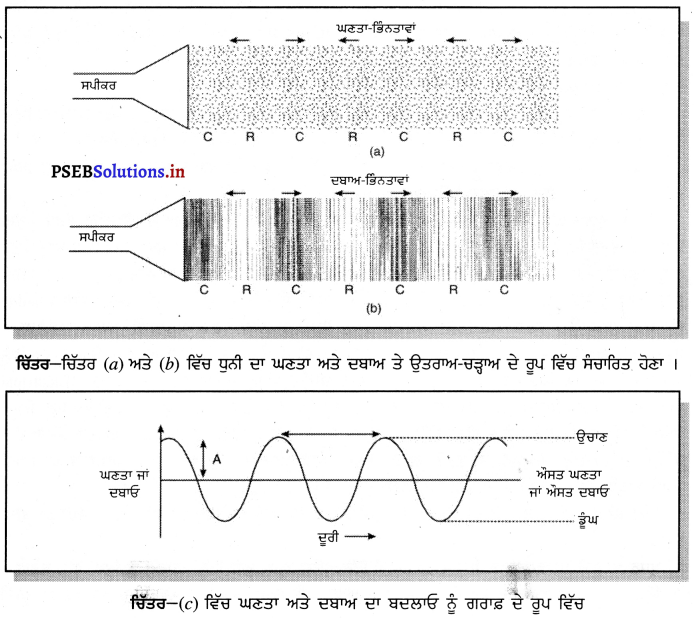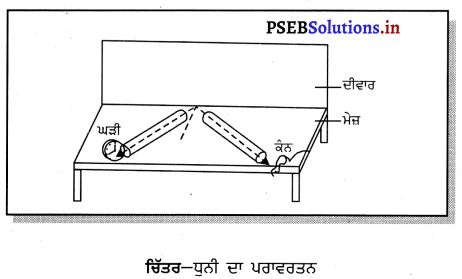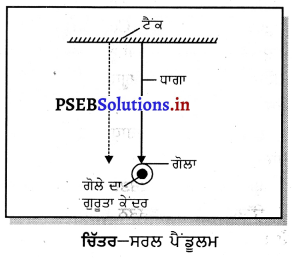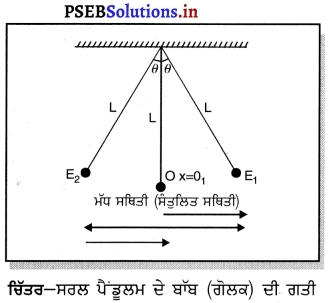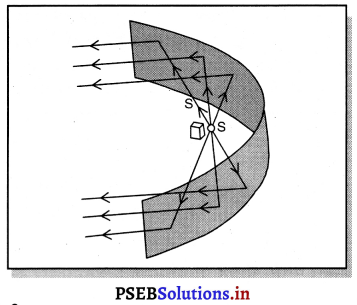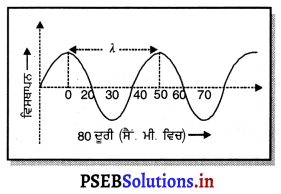Punjab State Board PSEB 9th Class Science Important Questions Chapter 5 ਜੀਵਨ ਦੀ ਮੁੱਢਲੀ ਇਕਾਈ Important Questions and Answers.
PSEB 9th Class Science Important Questions Chapter 5 ਜੀਵਨ ਦੀ ਮੁੱਢਲੀ ਇਕਾਈ
ਵੱਡੇ ਉੱਤਰਾਂ ਵਾਲੇ ਪ੍ਰਸ਼ਨ (Long Answer Type Questions)
ਪ੍ਰਸ਼ਨ 1.
ਪੌਦਾ ਸੈੱਲ ਦੀ ਇਲੈਕਟ੍ਰਾਂਨ ਸੂਖ਼ਮਦਰਸ਼ੀ ਹੇਠਾਂ ਬਣਤਰ ਦਾ ਚਿੱਤਰ ਬਣਾ ਕੇ ਵਰਣਨ ਕਰੋ ।
ਉੱਤਰ-
ਪੌਦਾ ਸੈੱਲ ਦੀ ਇਲੈੱਕਟਾਂਨ ਸੂਖ਼ਮਦਰਸ਼ੀ ਬਣਤਰ-ਅਲਟਾ ਸੂਖ਼ਮਦਰਸ਼ੀ ਦੁਆਰਾ ਪੌਦਾ ਸੈੱਲ ਦੀ ਰਚਨਾ ਹੇਠ ਲਿਖੀ ਹੈ । ਇਸ ਸੂਖ਼ਮਦਰਸ਼ੀ ਦੁਆਰਾ ਵੇਖੇ ਜਾਣ ਤੇ ਸੈੱਲ ਦੇ ਤਿੰਨ ਭਾਗ ਪ੍ਰਤੱਖ ਨਜ਼ਰ ਆਉਂਦੇ ਹਨ ਅਤੇ ਇਹ ਹਨ-
(i) ਸੈੱਲ-ਕੰਧ,
(ii) ਸੈੱਲ ਦਵ ਅਤੇ
(iii) ਨਿਊਕਲੀਅਸ ਜਾਂ ਕੇਂਦਰਕ ।
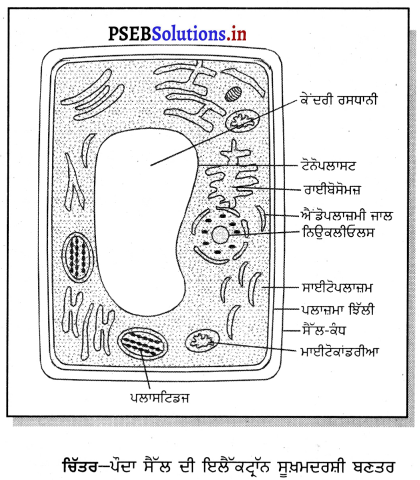
I. ਸੈੱਲ-ਕੰਧ (Cell wall) – ਪੌਦੇ ਸੈੱਲ ਦੇ ਬਾਹਰਲੇ ਪਾਸੇ ਵੱਲ ਮੌਜੂਦ ਪਰਤ ਨੂੰ ਸੈੱਲ ਕੰਧ ਆਖਦੇ ਹਨ । ਇਹ ਸੈਲੂਲੋਜ਼ ਦੀ ਬਣੀ
ਨਿਊਕਲੀਓਲਸ ਹੋਈ ਹੁੰਦੀ ਹੈ । ਸੈੱਲ ਕੰਧ ਪਾਰਗਮਨੀ (Permeable) ਹੈ । ਇਹ ਸੈੱਲ ਨੂੰ ਆਕਾਰ ਅਤੇ ਸੁਰੱਖਿਆ ਦਿੰਦੀ ਹੈ ।
II. ਸੈੱਲ ਦ੍ਰਵ ਜਾਂ ਸਾਈਟੋਪਲਾਜ਼ਮ (Cytoplasm) – ਇਹ ਜੈਲੀ ਰੂਪੀ (Jelly like) ਲਚਕਦਾਰ ਹੈ ਜਿਹੜਾ ਸੈੱਲ ਕੰਧ ਦੇ ਅੰਦਰਲੇ ਪਾਸੇ ਮੌਜੂਦ ਹੁੰਦਾ ਹੈ । ਇਸ ਦੀ ਪ੍ਰਕਿਰਤੀ ਕੋਲਾਇਡੀ (Colloidal) ਹੈ । ਸੈੱਲਾਂ ਅੰਦਰ ਹੋਣ ਵਾਲੀਆਂ ਸਾਰੀਆਂ ਦੀਆਂ ਸਾਰੀਆਂ ਜੈਵਿਕ ਕਿਰਿਆਵਾਂ ਇਸ ਵਿੱਚ ਹੁੰਦੀਆਂ ਹਨ । ਇਸ ਵਿੱਚ ਕਾਰਬੋਹਾਈਡਰੇਟ, ਪ੍ਰੋਟੀਨ, ਲਿਪਿਡ (Lipids) ਅਤੇ ਖਣਿਜਾਂ ਦੇ ਲੁਣ ਜਮਾਂ ਕੀਤੇ ਗਏ ਹੁੰਦੇ ਹਨ । ਇਸ ਵਿੱਚ ਹੇਠਾਂ ਲਿਖੇ ਪਿੰਡ ਪਾਏ ਜਾਂਦੇ ਹਨ-
(i) ਪਲਾਸਟਿਡਜ਼ (Plastids) – ਪੌਦਿਆਂ ਦੇ ਸੈੱਲਾਂ ਵਿੱਚ ਪਾਏ ਜਾਣ ਵਾਲੇ ਪਲਾਸਟਿਡਜ਼ ਤਿੰਨ ਪ੍ਰਕਾਰ ਦੇ ਹਨ(ਉ) ਕਲੋਰੋਪਲਾਸਟ, (ਅ) ਕੋਮੋਪਲਾਸਟ ਅਤੇ (ਇ) ਨਿਊਕੋਪਲਾਸਟ ।
(ਉ) ਕਲੋਰੋਪਲਾਸਟ (Chloroplasts) – ਇਹਨਾਂ ਬਣਤਰਾਂ ਵਿੱਚ ਕਲੋਰੋਫਿਲ ਨਾਂ ਦਾ ਵਰਣਕ ਹੁੰਦਾ ਹੈ ਅਤੇ ਇਹਨਾਂ ਵਿੱਚ ਪ੍ਰਕਾਸ਼ ਸੰਸ਼ਲੇਸ਼ਣ ਪ੍ਰਕਿਰਿਆ ਹੁੰਦੀ ਹੈ । ਪੌਦਿਆਂ ਦੇ ਹਰੇ ਰੰਗ ਦਾ ਕਾਰਨ ਕਲੋਰੋਫਿਲ ਹੀ ਹੈ ।
(ਅ) ਕੋਮੋਪਲਾਸਟ (Chromoplasts) – ਇਹਨਾਂ ਪਲਾਸਟਿਡਜ਼ ਦੀ ਰੰਗਤ ਹਰੇ ਰੰਗ ਦੇ ਇਲਾਵਾ, ਹੋਰ ਲਗਪਗ ਸਾਰੇ ਹੀ ਰੰਗਾਂ, ਜਿਵੇਂ ਕਿ ਲਾਲ, ਪੀਲਾ, ਜਾਮਣੀ, ਗੁਲਾਬੀ ਅਤੇ ਸਫੈਦ ਰੰਗ ਮੌਜੂਦ ਹੁੰਦੇ ਹਨ । ਸ਼੍ਰੋਮੋਪਲਾਸਟ ਆਮ ਤੌਰ ‘ਤੇ ਫੁੱਲ ਪੱਤੀਆਂ (Petals) ਅਤੇ ਪੱਕੇ ਹੋਏ ਦਾਦਾਰ ਫਲਾਂ ਤੇ ਛਿਲਕਿਆਂ ਅੰਦਰ ਪਾਏ ਜਾਂਦੇ ਹਨ ।
(ੲ) ਲਿਊਕੋਪਲਾਸਟ (Leucoplast)-
(i) ਇਹ ਰੰਗ ਹੀ ਪਲਾਸਟਿਡ ਹਨ ਜਿਹੜੇ ਕਿ ਪੌਦਿਆਂ ਦੇ ਭੂਮਿਆਈ ਹਿੱਸਿਆਂ (Under ground Parts) ਵਿੱਚ ਪਾਏ ਜਾਂਦੇ ਹਨ । ਇਹ ਭੋਜਨ ਸਟੋਰ ਕਰਨ ਦਾ ਕਾਰਜ ਕਰਦੇ ਹਨ ।
(ii) ਰਸਦਾਨੀਆਂ (Vacuoles) – ਪੌਦਾ ਸੈੱਲ ਵਿੱਚ ਰਸਦਾਨੀਆਂ ਬੜੀਆਂ ਸਪੱਸ਼ਟ ਹਨ ਅਤੇ ਇਹਨਾਂ ਵਿੱਚ ਸੈਂਲ ਰਸ (Cell sap) ਦਾ ਭੰਡਾਰ ਕੀਤਾ ਗਿਆ ਹੁੰਦਾ ਹੈ । ਇਹ ਰਸਦਾਨੀਆਂ ਸੈੱਲਾਂ ਦੇ ਲਗਪਗ 90% ਭਾਗ ਬਣਾਉਣ ਲਈ ਜ਼ਿੰਮੇਵਾਰ ਮੰਨੀਆਂ ਗਈਆਂ ਹਨ । ਇਹ ਰਸਦਾਨੀਆਂ ਸੈੱਲ ਵਿੱਚਲੇ ਅੰਗੜਿਆਂ ਨੂੰ ਸੈੱਲ ਕੰਧ ਵੱਲ ਧੱਕ ਦਿੰਦੀਆਂ ਹਨ । ਇਹ ਰਸਦਾਨੀਆਂ ਸੈੱਲਾਂ ਦੇ ਸਫੀਤੀ ਫੈਲਾਓ ਅਤੇ ਦ੍ਰਿੜ੍ਹਤਾ ਲਈ ਵੀ ਭੂਮਿਕਾ ਨਿਭਾਉਂਦੀਆਂ ਹਨ ।
(iii) ਮਾਈਟੋਕਾਂਡਰੀਆ (Mitochondria) – ਇਹਨਾਂ ਨੂੰ ਸੈੱਲ ਦੇ ਊਰਜਾ ਘਰ (Power House) ਵੀ ਆਖਿਆ ਜਾਂਦਾ ਹੈ । ਇਹ ਭੋਜਨ ਪਦਾਰਥ ਵਿਸ਼ੇਸ਼ ਕਰਕੇ ਕਾਰਬੋਹਾਈਡੇਟਜ਼ ਦਾ ਆਕਸੀਕਰਨ ਕਰਕੇ ਤਾਪ ਊਰਜਾ ਪੈਦਾ ਕਰਦੇ ਹਨ । ਮਾਈਟੋਕਾਂਡਰੀਆ ਨੂੰ ਕੌਡੀਓਸੋਮਜ਼ (Chondriosomes) ਵੀ ਆਖਿਆ ਜਾਂਦਾ ਹੈ ।
(iv) ਐਂਡੋਪਲਾਜ਼ਮੀ ਜਾਲ (Endoplasmic Reticulum) – ਇਹ ਵ ਨਾਲ ਭਰੇ ਤਿੱਲੀ ਰੂਪ ਜਾਲ ਹਨ । ਇਹ ਦੋ ਤਰ੍ਹਾਂ ਦੇ ਹੁੰਦੇ ਹਨ । ਖੁਰਦਰੇ ਐਂਡੋਪਲਾਜ਼ਮੀ ਜਾਲ, ਜਿਸਦੀ ਤਹਿ ਤੇ ਪ੍ਰੋਟੀਨ ਬਣਾਉਣ ਲਈ ਰਾਈਬੋਸੋਮਜ਼ ਲੱਗੇ ਹੁੰਦੇ ਹਨ । ਪੱਧਰੇ ਐਂਡੋਪਲਾਜ਼ਮੀ ਜਾਲ, ਜਿਸਦੇ ਰਾਈਬੋਸੋਮਜ਼ ਨਹੀਂ ਹੁੰਦੇ ਅਤੇ ਇਹ ਲਿਪਿਡ ਦਾ ਰਿਸਾਓ ਕਰਦੇ ਹਨ । ਰਾਈਬੋਸੋਮਜ਼ ਵੱਖਰੇ ਤੌਰ ‘ਤੇ ਸੈੱਲ-ਪਦਾਰਥ ਵਿੱਚ ਵੀ ਹੁੰਦੇ ਹਨ । ਐਂਡੋਪਲਾਜ਼ਮੀ ਜਾਲ ਵਿੱਚ ਪੈਦਾ ਹੋਏ ਕੁੱਝ ਪ੍ਰੋਟੀਨ ਅਤੇ ਲਿਪਿਡ ਸੈੱਲ ਦੇ ਨਵੇਂ ਹਿੱਸੇ ਜਿਵੇਂ ਸੈੱਲ-ਤਿੱਲੀ ਬਣਾਉਣ ਲਈ ਵਰਤੇ ਜਾਂਦੇ ਹਨ | ਕੁੱਝ ਪ੍ਰੋਟੀਨ ਜਦੋਂ ਸੈੱਲ ਅੰਦਰ ਜਾਂ ਬਾਹਰ ਰਿਸਦੇ ਹਨ, ਐਨਜਾਈਮ ਅਤੇ ਹਾਰਮੋਨ ਦੇ ਤੌਰ ‘ਤੇ ਕੰਮ ਕਰਦੇ ਹਨ ।
(v) ਰਾਈਬੋਸੋਮਜ਼ (Ribosomes) – ਲਾਲ ਰਕਤਾਣੂਆਂ ਅਤੇ ਵਿਕਸਿਤ ਸ਼ੁਕਰਾਣੂਆਂ ਤੋਂ ਇਲਾਵਾ ਇਹ ਕੇਰੀਓਟਿਕ ਅਤੇ ਯੁਕੇਰੀਓਟਿਕ ਸਾਰੇ ਸੈੱਲਾਂ ਵਿੱਚ ਪਾਏ ਜਾਂਦੇ ਹਨ | ਹਰ ਰਾਈਬੋਸੋਮ ਦੇ ਦੋ ਭਾਗ ਹੁੰਦੇ ਹਨ । ਇੱਕ ਛੋਟਾ ਸਬ-ਯੂਨਿਟ ਅਤੇ ਇੱਕ ਵੱਡਾ ਸਬ-ਯੂਨਿਟ ਹੁੰਦਾ ਹੈ । ਰਾਈਬੋਸੋਮ ਆਰ. ਐੱਨ. ਏ. (RNA) ਅਤੇ ਪ੍ਰੋਟੀਨ ਦੇ ਬਣੇ ਹੁੰਦੇ ਹਨ । ਇਹ ਸੈੱਲ ਅੰਦਰ ਪ੍ਰੋਟੀਨ ਦਾ ਨਿਰਮਾਣ ਕਰਦੇ ਹਨ ।
(vi) ਗਾਲਜੀ ਕਾਇਆਵਾਂ (Golgi Apparatus) – ਗਾਲਜੀ ਕਾਇਆਵਾਂ ਇੱਕ ਪੱਧਰੇ, ਚਪਟੇ ਅਤੇ ਥੈਲੀਨੁਮਾ ਰਚਨਾਵਾਂ ਦਾ ਸਮੂਹ ਹੈ । ਇਹ ਸਮਾਨੰਤਰ ਲਾਈਨ ਵਿੱਚ ਅਕਸਰ ਇੱਕ-ਦੂਜੇ ਤੇ ਟਿਕੇ ਹੋਏ ਹੁੰਦੇ ਹਨ | ਗਾਲਜੀ ਕਾਇਆਵਾਂ ਸੈੱਲ ਦੇ ਇੱਕ ਰਿਸਾਉਣ ਅੰਗ ਹਨ । ਇਹ ਕਾਇਆਵਾਂ ਐਂਡੋਪਲਾਜ਼ਮੀ ਜਾਲ ਵਿੱਚ ਤਿਆਰ ਪਦਾਰਥਾਂ ਨੂੰ ਇਕੱਠਾ ਕਰਦੀਆਂ ਹਨ ਅਤੇ ਇਸ ਨੂੰ ਪਲਾਜ਼ਮਾ ਤਿੱਲੀ ਅਤੇ ਲਾਈਸੋਸੋਮਜ਼ ਤੱਕ ਸੈੱਲ ਤੋਂ ਬਾਹਰ ਵੱਲ ਲੈ ਕੇ ਜਾਂਦੀਆਂ ਹਨ । ਇਹ ਲਾਈਸੋਸੋਮਜ਼ ਅਤੇ ਪਰਆਕਸੀਸੋਮਜ਼ ਬਣਾਉਣ ਵਿੱਚ ਹੀ ਸਹਾਈ ਹੁੰਦੀਆਂ ਹਨ । ਗਾਲਜੀ ਕਾਇਆਵਾਂ ਨੂੰ ਪੌਦਿਆਂ ਵਿੱਚ ਡਿਕਟਿਉਸੋਮ ਆਖਿਆ ਜਾਂਦਾ ਹੈ ।
III. ਨਿਊਕਲੀਅਸ ਜਾਂ ਕੇਂਦਰਕ (Nucleus) – ਇਹ ਗੋਲ ਆਕਾਰ ਦਾ ਸੈੱਲ ਦੇ ਵਿਚਕਾਰ ਸਥਿਤ ਬਹੁਤ ਹੀ ਮਹੱਤਵਪੂਰਨ ਅੰਗ ਹੈ । ਇਹ ਦੋ ਪਰਤਾਂ ਵਾਲੀ ਮੁਸਾਮਦਾਰ ਕੇਂਦਰਕ ਬਿੱਲੀ (Nuclear membrane) ਨਾਲ ਘਿਰਿਆ ਹੁੰਦਾ ਹੈ । ਇਸ ਦੇ ਅੰਦਰ ਇੱਕ ਤਰਲ ਹੁੰਦਾ ਹੈ ਜਿਸਨੂੰ ਨਿਊਕਲੀਓਪਲਾਜ਼ਮ (Nucleoplasm) ਆਖਦੇ ਹਨ । ਨਿਊਕਲੀਓਪਲਾਜ਼ਮ ਵਿੱਚ ਬਿਨਾਂ ਝਿੱਲੀ ਵਾਲੇ ਇੱਕ ਜਾਂ ਇੱਕ ਤੋਂ ਵੱਧ ਨਿਊਕਲੀਓਲਸ (Nucleolus) ਅਤੇ ਕੂਮੈਟਿਨ (Chromatin) ਹੁੰਦੇ ਹਨ । ਨਿਊਕਲੀਓਲਸ ਵਿੱਚ ਪ੍ਰੋਟੀਨ ਅਤੇ ਆਰ. ਐੱਨ. ਏ. ਭਰਿਆ ਹੁੰਦਾ ਹੈ ਅਤੇ ਇੱਥੇ ਹੀ ਰਾਈਬੋਸੋਮ ਬਣਦੇ ਹਨ । ਕੂਮੈਟਿਨ ਪਤਲਾ ਧਾਗੇ ਜਿਹਾ ਪਦਾਰਥ ਹੁੰਦਾ ਹੈ, ਜੋ ਜਣਨ ਪਦਾਰਥ ਡੀ. ਐੱਨ. ਏ. (DNA) ਅਤੇ ਪ੍ਰੋਟੀਨ ਤੋਂ ਮਿਲ ਕੇ ਬਣਦਾ ਹੈ । ਕੂਮੈਟਿਨ ਤੋਂ ਗੁਣਸੂਤਰ ਬਣਦੇ ਹਨ ਜਿਨ੍ਹਾਂ ਉੱਪਰ ਜੀਨਜ਼ (Genes) ਲੱਗੇ ਹੁੰਦੇ ਹਨ । ਜੀਨਜ਼ ਅਨੁਵੰਸ਼ਿਕ ਸੂਚਨਾ ਦੀ ਇਕਾਈ ਹੁੰਦੇ ਹਨ । ਨਿਊਕਲੀਅਸ ਜਾਂ ਕੇਂਦਰਕ ਸੈੱਲ ਦੀਆਂ ਸਾਰੀਆਂ ਕਿਰਿਆਵਾਂ ਨੂੰ ਕੰਟਰੋਲ ਕਰਦਾ ਹੈ ।
![]()
ਪ੍ਰਸ਼ਨ 2.
ਸੈੱਲ ਦੇ ਕੇਂਦਰਕ ਦੀ ਸੰਰਚਨਾ ਅਤੇ ਕਾਰਜ ਦਾ ਸੰਖੇਪ ਵਰਣਨ ਕਰੋ ।
ਉੱਤਰ-
ਸੈੱਲ ਦੇ ਮੱਧ ਵਿੱਚ ਮੌਜੂਦ ਗੋਲਾਕਾਰ ਜਾਂ ਅੰਡਾਕਾਰ ਸੰਰਚਨਾ ਨੂੰ ਕੇਂਦਰਕ ਕਹਿੰਦੇ ਹਨ । ਇਸ ਦੀ ਸਭ ਤੋਂ ਪਹਿਲਾਂ ਰਾਬਰਟ ਬਰਾਉਣ ਨੇ ਖੋਜ ਕੀਤੀ ਸੀ । ਆਮ ਕਰਕੇ ਇੱਕ ਸੈੱਲ ਵਿੱਚ ਇੱਕ ਕੇਂਦਰਕ ਹੁੰਦਾ ਹੈ । ਕੇਂਦਰਕ ਦੇ ਅੱਗੇ ਲਿਖੇ ਮੁੱਖ ਭਾਗ ਹਨ-
(i) ਕੇਂਦਰਕ ਬਿੱਲੀ – ਕੇਂਦਰਕ ਦੇ ਦੁਆਲੇ ਇੱਕ ਦੋਹਰੀ ਪਰਤ ਦਾ ਆਵਰਨ ਹੁੰਦਾ ਹੈ, ਜਿਸ ਨੂੰ ਕੇਂਦਰਕ ਝਿੱਲੀ ਕਹਿੰਦੇ ਹਨ ।ਇਸ ਵਿੱਚ ਕਈ ਛੋਟੇ-ਛੋਟੇ ਛੇਕ ਹੁੰਦੇ ਹਨ ਜਿਨ੍ਹਾਂ ਦੁਆਰਾ ਕੇਂਦਰਕ ਦੇ ਅੰਦਰਲਾ ਦ੍ਰਵ ਕੇਂਦਰ ਤੋਂ ਬਾਹਰ ਜਾ ਸਕਦਾ ਹੈ । ਪ੍ਰੋਕੈਰੀਓਟਿਕ ਸੈਲਾਂ ਵਿੱਚ ਕੇਂਦਰਕ ਝੱਲੀ ਨਹੀਂ ਹੁੰਦੀ ।
(ii) ਕੇਂਦਰਕ-ਦ੍ਰਵ – ਕੇਂਦਰਕ ਬਿੱਲੀ ਨਾਲ ਰੇ ਪਦਾਰਥ ਨੂੰ ਕੇਂਦਰਕ-ਦਵ ਕਹਿੰਦੇ ਹਨ । ਇਹ ਪਾਰਦਰਸ਼ੀ, ਕੋਲਾਇਡੀ ਤਰਲ ਹੁੰਦਾ ਹੈ ਜੋ ਨਿਊਕਲੀ ਪ੍ਰੋਟੀਨ ਤੋਂ ਬਣਿਆ ਹੁੰਦਾ ਹੈ । ਇਸ ਵਿੱਚ ਰਾਈਬੋ ਸੋਸ, ਖਣਿਜ ਲੂਣ ਐਨਜਾਈਮ, ਆਰ. ਐੱਨ. ਏ., ਸ਼੍ਰੋਮੋਟੀਨ, ਧਾਗੇ ਅਤੇ ਕੇਂਦਰਕ ਪਾਇਆ ਜਾਂਦਾ ਹੈ ।
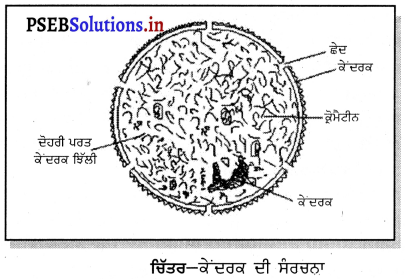
(iii) ਭੋਮੈਟੀਨ ਪਦਾਰਥ – ਕੋਮੋਟੀਨ ਪਦਾਰਥ ਧਾਗੇ ਵਰਗੀਆਂ ਬਾਰੀਕ ਰਚਨਾਵਾਂ ਦਾ ਜਾਲ ਹੁੰਦਾ ਹੈ । ਜਦੋਂ ਕਦੇ ਸੈੱਲ ਦਾ ਵਿਭਾਜਨ ਹੋਣ ਵਾਲਾ ਹੁੰਦਾ ਹੈ ਤਾਂ ਇਹ ਕੋਮੋਸੋਮ ਵਿੱਚ ਸੰਗਠਿਤ ਹੋ ਜਾਂਦਾ ਹੈ । ਕੋਮੋਸੋਮ (ਗੁਣਤਰ ਵਿੱਚ ਅਨੁਵੰਸ਼ਿਕ ਗੁਣ ਹੁੰਦੇ ਹਨ ਜੋ ਮਾਤਾ-ਪਿਤਾ ਤੋਂ DNA (ਡੀਆਕਸੀ ਰਾਈਬੋਨਿਊਕਲਿਕ ਅਮਲ) ਅਣੂ ਦੇ ਰੂਪ ਵਿੱਚ ਅਗਲੀ ਪੀੜੀ ਵਿੱਚ ਜਾਂਦੇ ਹਨ । ਡੀ.ਐੱਨ.ਏ. ਅਤੇ ਪ੍ਰੋਟੀਨ ਤੋਂ ਗੁਣਸੂਤਰ ਬਣਦੇ ਹਨ ਅਤੇ ਇਹਨਾਂ ਵਿੱਚ ਕੋਸ਼ਿਕਾ ਦੇ ਨਿਰਮਾਣ ਅਤੇ ਸੰਗਠਨ ਦੀਆਂ ਸਾਰੀਆਂ ਵਿਸ਼ੇਸ਼ਤਾਵਾਂ ਮੌਜੂਦ ਹੁੰਦੀਆਂ ਹਨ । ਡੀ. ਐੱਨ. ਏ. ਦੇ ਕਿਰਿਆਤਮਕ ਭਾਗ ਨੂੰ ਜੀਨ ਕਹਿੰਦੇ ਹਨ । ਜਿਸ ਸੈੱਲ ਦਾ ਵਿਭਾਜਨ ਨਹੀਂ ਹੋ ਰਿਹਾ ਹੁੰਦਾ ਉਸ ਵਿੱਚ ਡੀ. ਐੱਨ. ਏ. ਕੋਮੋਟੀਨ ਦੇ ਰੂਪ ਵਿੱਚ ਰਹਿੰਦਾ ਹੈ । ਵੱਖ ਜੀਵਾਂ ਵਿੱਚ ਸ਼੍ਰੋਮੋਸੋਮ ਦੀ ਸੰਖਿਆ ਵੱਖ-ਵੱਖ ਹੁੰਦੀ ਹੈ ਪਰ ਇਕ ਹੀ ਜਾਤੀ ਦੇ ਸਾਰੇ ਪਾਣੀਆਂ ਵਿੱਚ ਇਹਨਾਂ ਦੀ ਗਿਣਤੀ ਇੱਕੋ ਜਿਹੀ ਹੁੰਦੀ ਹੈ । ਕੋਮੋਸੋਮ ਦੀ ਸੰਰਚਨਾ ਵਿੱਚ ਪਰਿਵਰਤਨ ਹੋਣ ਤੇ ਜੀਵ-ਜੰਤੂਆਂ ਵਿੱਚ ਵਖਰੇਵਾਂ ਪੈਦਾ ਹੋ ਜਾਂਦਾ ਹੈ । ਕੇਂਦਰਕ ਵਿੱਚ ਆਰ. ਐੱਨ. ਏ. ਰਾਈਬੋਨਿਊਕਲਿਕ ਅਮਲ ਹੈ ਜੋ ਕੇਂਦਰਿਕਾ ਵਿੱਚ ਪ੍ਰੋਟੀਨ ਸੰਸ਼ਲੇਸ਼ਣ ਵਿੱਚ ਸਹਾਇਕ ਹੁੰਦਾ ਹੈ ।
(iv) ਕੇਂਦਰਿਕਾ – ਸੈੱਲ ਦੇ ਕੇਂਦਰਕ ਵਿੱਚ ਇੱਕ ਜਾਂ ਦੋ ਕੇਂਦਰਿਕਾ ਹੁੰਦੀਆਂ ਹਨ । ਇਸ ਵਿੱਚ ਪ੍ਰੋਟੀਨ, ਆਰ. ਐੱਨ.ਏ. ਅਤੇ ਡੀ.ਐੱਨ.ਏ. ਹੁੰਦੇ ਹਨ । ਪ੍ਰੋਕੈਰੀਓਟਿਕ ਸੈੱਲਾਂ ਵਿੱਚ ਕੇਂਦਰਿਕ ਨਹੀਂ ਹੁੰਦੀ । ਬੈਕਟੀਰੀਆ ਵਰਗੇ ਕੁੱਝ ਜੀਵਾਂ ਵਿੱਚ ਕੋਸ਼ਿਕਾ ਦਾ ਕੇਂਦਰਕ ਭਾਗ ਘੱਟ ਸਪੱਸ਼ਟ ਹੁੰਦਾ ਹੈ, ਕਿਉਂਕਿ ਇਸ ਵਿੱਚ ਕੇਂਦਰਕ ਬਿੱਲੀ ਮੌਜੂਦ ਨਹੀਂ ਹੁੰਦੀ ।
ਕੇਂਦਰਕ ਦੇ ਕਾਰਜ-
- ਇਹ ਅਨੁਵੰਸ਼ਿਕ ਲੱਛਣਾਂ ਨੂੰ ਇੱਕ ਪੀੜੀ ਤੋਂ ਦੂਸਰੀ ਪੀੜੀ ਤੱਕ ਸਥਾਨਾਂਤਰਨ ਦਾ ਆਧਾਰ ਹੈ ।
- ਇਹ ਕੋਸ਼ਿਕਾ ਵਿਭਾਜਨ ਦੇ ਲਈ ਜ਼ਿੰਮੇਵਾਰ ਹੁੰਦਾ ਹੈ ।
- ਇਹ ਕੋਸ਼ਿਕਾ ਦੀਆਂ ਸਾਰੀਆਂ ਢਾਹੂ ਉਸਾਰੂ ਕਿਰਿਆਵਾਂ ਨੂੰ ਕਾਬੂ ਕਰਦਾ ਹੈ ।
- ਇਹ ਸਰੀਰ ਦੇ ਵਾਧੇ ਲਈ ਜ਼ਿੰਮੇਵਾਰ ਹੁੰਦਾ ਹੈ ।
ਪ੍ਰਸ਼ਨ 3.
ਹੇਠ ਲਿਖਿਆਂ ‘ਤੇ ਨੋਟ ਲਿਖੋ-
1. ਕਲੋਰੋਪਲਾਸਟ,
2. ਗਾਲਜੀ ਕਾਇਆਵਾਂ ।
ਉੱਤਰ-
1. ਕਲੋਰੋਪਲਾਸਟ (Chloroplast) – ਇਹ ਪਿੰਡ ਪੌਦਿਆਂ ਦੇ ਹਰੇ ਰੰਗ ਵਾਲੇ ਹਿੱਸਿਆਂ ਵਿਸ਼ੇਸ਼ ਕਰਕੇ ਪੱਤਿਆਂ ਵਿੱਚ ਪਾਏ ਜਾਂਦੇ ਹਨ । ਇਹਨਾਂ ਦੀ ਪ੍ਰਤੀ ਸੈੱਲ ਸੰਖਿਆ ਇੱਕ ਤੋਂ ਲੈ ਕੇ 100 ਤੱਕ ਹੋ ਸਕਦੀ ਹੈ । ਇਹਨਾਂ ਦਾ ਆਕਾਰ ਆਮ ਤੌਰ ‘ਤੇ ਤਸ਼ਤਰੀਨੁਮਾ (Saucer shaped) ਹੁੰਦਾ ਹੈ ।
ਕੁੱਝ ਸੈੱਲਾਂ ਵਿੱਚ ਕਲੋਰੋਪਲਾਸਟ ਗੋਲਾਕਾਰ ਆਕਾਰ ਦੇ ਵੀ ਹਨ । ਸਪਾਇਰੋਗਾਇਰਾ (Spirogyra) ਦੇ ਸੈੱਲ ਵਿੱਚ ਵਿਲ ਕਲੋਰੋਪਲਾਸਟ ਫੀਤੇ ਦੀ ਸ਼ਕਲ ਦੇ ਅਤੇ ਸਪਾਇਰਲ ਦੀ ਸ਼ਕਲ ਵਿੱਚ ਕੁੰਡਲਿਤ ਹੁੰਦੇ ਹਨ । (ਚਿੱਤਰ) ਪਰ ਕਲੈਮੀਡੋਮੋਨਾਸ (Chlamydomonas) ਦੇ ਸੈੱਲ ਵਿਚਲੇ ਕਲੋਰੋਪਲਾਸਟ ਦੀ ਸ਼ਕਲ ਪਿਆਲੀ ਵਰਗੀ (Cup Shaped) ਹੁੰਦੀ ਹੈ ।
ਕਲੋਰੋਪਲਾਸਟ ਦੇ ਸਾਰੇ ਪਾਸਿਆਂ ਤੇ ਤਿੱਲੀ ਦੀ ਦੁਹਰੀ ਪਰਤ ਹੁੰਦੀ ਹੈ । ਕਲੋਰੋਪਲਾਸਟ ਦੇ ਅੰਦਰ ਇੱਕ-ਦੂਸਰੇ ਦੇ ਉੱਪਰ ਗੱਠਾਂ (Stacks) ਦੀ ਸ਼ਕਲ ਵਿੱਚ ਤਸ਼ਤਰੀ ਰੂਪੀ ਪਿੰਡਾਂ ਦੇ ਸਮੂਹ ਬਣੇ ਹੋਏ ਹੁੰਦੇ ਹਨ । ਇਹਨਾਂ ਨੂੰ ਥਾਈਲੈਕਾਇਡਜ਼, (Thylakoids) ਆਖਦੇ ਹਨ । ਗ੍ਰੇਨਾ (grana) ਇੱਕ ਦੂਸਰੇ ਨਾਲ ਨੀ ਲੈਮੈਲੀ (Granal lamella) ਦੁਆਰਾ ਜੁੜੇ ਹੁੰਦੇ ਹਨ । ਥਾਈਲੈਕਾਇਡਜ਼, ਸਟਰੋਮਾ ਦੇ ਅੰਦਰ ਇੱਕ-ਦੂਸਰੇ ਦੇ ਉੱਪਰ ਚੜ੍ਹੇ ਹੋਏ ਹੁੰਦੇ ਹਨ । (ਚਿੱਤਰ) ਕਲੋਰੋਪਲਾਸਟ ਵਿੱਚ ਅਨੁਵੰਸ਼ਿਕ ਪਦਾਰਥ ਡੀ. ਐੱਨ. ਏ. (D.N.A.) ਵੀ ਹੁੰਦਾ ਹੈ | ਕਲੋਰੋਪਲਾਸਟ ਵਿੱਚ ਸਮਾਂ ਨਾਂ ਵਾਲਾ ਪਦਾਰਥ ਵੀ ਪਾਇਆ ਜਾਂਦਾ ਹੈ ।
ਕਲੋਰੋਪਲਾਸਟ ਦੇ ਕਾਰਜ-
- ਕਲੋਰੋਪਲਾਸਟ ਪ੍ਰਕਾਸ਼ ਸੰਸ਼ਲੇਸ਼ਣ ਕਿਰਿਆ ਕਰਕੇ CO2 ਅਤੇ H2O ਤੋਂ, ਸੂਰਜ ਦੀ ਰੌਸ਼ਨੀ ਦੀ ਮੌਜੂਦਗੀ ਵਿੱਚ ਭੋਜਨ ਤਿਆਰ ਕਰਦੇ ਹਨ ।
- ਪ੍ਰਕਾਸ਼ ਸੰਸ਼ਲੇਸ਼ਣ ਦੀ ਪ੍ਰਕਿਰਿਆ ਸਮੇਂ ਆਕਸੀਜਨ ਮੁਕਤ ਹੁੰਦੀ ਹੈ ।
- ਕਲੋਰੋਪਲਾਸਟ CO2 ਦਾ ਸਥਿਰੀਕਰਨ ਕਰਦੇ ਹਨ । ਇਸ ਤਰ੍ਹਾਂ ਕਰਨ ਨਾਲ ਇਹ ਪਿੰਡ ਵਾਯੂਮੰਡਲ ਵਿੱਚ CO2 ਦੀ ਮਾਤਰਾ ‘ਤੇ ਕੰਟਰੋਲ ਰੱਖਦੇ ਹਨ ।
- ਕੋਲੋਰੋਪਲਾਸਟ ਕੁੱਝ ਹਾਲਤਾਂ ਵਿੱਚ ਸ਼੍ਰੋਮੋਪਲਾਸਟਾਂ ਵਿੱਚ ਬਦਲ ਜਾਂਦੇ ਹਨ ਜਿਵੇਂ ਕਿ ਫਲਾਂ ਦੇ ਛਿੱਲੜ ।
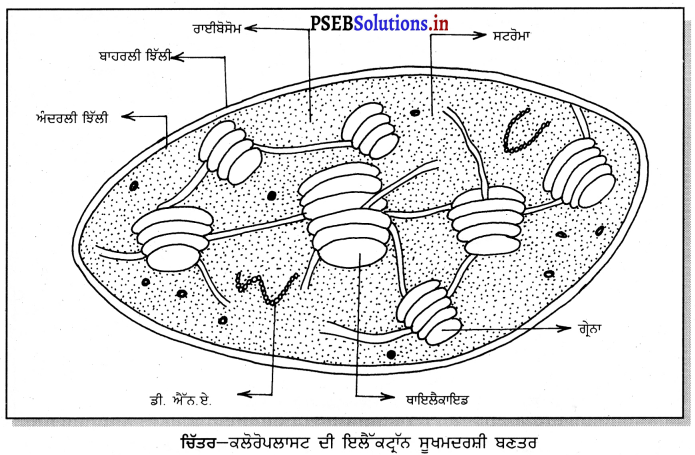
2. ਗਾਲਜੀ ਕਾਈਆਵਾਂ (Golgi Apparatus) – ਇਹਨਾਂ ਨੂੰ ਗਾਲਜੀ ਅਪ੍ਰੇਟਸ ਜਾਂ ਗਾਲਜੀ ਕੰਪਲੈਕਸ (ਗਾਲਜੀ ਸਮੂਹ) ਵੀ ਆਖਦੇ ਹਨ ।
ਇਹ ਪਿੰਡ ਪੱਲੀ ਸੈਕਰਾਈਡਜ਼, ਲਿਪਿਡਜ਼ ਅਤੇ ਹੋਰਨਾਂ ਪਦਾਰਥਾਂ ਦੀ ਰਹਿੰਦ-ਖੂੰਹਦ ਨੂੰ ਸੈੱਲਾਂ ਵਿੱਚੋਂ ਬਾਹਰ ਕੱਢਣ ਦਾ ਕਾਰਜ ਕਰਦੇ ਹਨ ।
ਪੌਦਿਆਂ ਵਿੱਚ ਇਹ ਪਿੰਡ ਸੈੱਲ ਕੰਧ ਦੇ ਬਣਨ ਵਿੱਚ ਸਹਾਈ ਮੰਨੀ ਗਈ ਹੈ । ਗਾਲਜੀ ਪਿੰਡ ਥੈਲੀਆਂ, ਪਟਕਾਵਾਂ ਅਤੇ ਨਲੀਆਂ ਦੀਆਂ ਬਣੀਆਂ ਹੁੰਦੀਆਂ ਹਨ । ਇਹ ਥੈਲੀ ਜਾਂ ਥੈਲੇ ਦੇ ਸਮਾਨ ਹੁੰਦੀਆਂ ਹਨ ਅਤੇ ਇਹ ਥੈਲੀਆਂ ਜਾਂ ਪਟਕਾਵਾਂ ਇੱਕ ਦੂਸਰੇ ਦੇ ਉੱਪਰ ਸਥਿਤ ਹੁੰਦੀਆਂ ਹਨ ।

ਇਹਨਾਂ ਦੀ ਸੰਖਿਆ ਕੁੱਝ ਤੋਂ ਲੈ ਕੇ ਕਾਫ਼ੀ ਤੱਕ ਹੋ ਸਕਦੀ ਹੈ । ਵੈਸੀਕਲ, ਰਸਦਾਨੀ ਅਤੇ ਸਿਸਟਰਾਨੀ ਗਾਲਜੀ ਕਾਈਆਵਾਂ (Golgi Apparatus) ਦੇ ਤਿੰਨ ਭਾਗ ਹਨ । ਰਸਦਾਨੀਆਂ ਦੀ ਉਤਪੱਤੀ ਸਿਸਟਰਾਨੀ ਤੋਂ ਹੁੰਦੀ ਹੈ । ਇਹਨਾਂ ਦਾ ਕਾਰਜ ਰਿਸਾਓ (Secretary) ਵੀ ਹੈ ।
![]()
ਪ੍ਰਸ਼ਨ 4.
ਮਾਈਟੋਕਾਂਡਰੀਆ ਦਾ ਸਚਿੱਤਰ ਵਰਣਨ ਕਰੋ । ਇਸ ਨੂੰ ਸੈੱਲ ਦਾ ਊਰਜਾ ਘਰ ਕਿਉਂ ਆਖਿਆ ਜਾਂਦਾ ਹੈ ?
ਉੱਤਰ-
ਮਾਈਟੋਕਾਂਡਰੀਆ (Mitochondria) – ਸੈੱਲ ਵਿੱਚ ਇਹ ਬਹੁਤ ਹੀ ਸੂਖ਼ਮ ਨਿੱਕਾ ਅੰਗੜਾ ਹੈ, ਜਿਹੜਾ ਸੈੱਲਾਂ ਵਿੱਚ ਬਹੁਤ ਜ਼ਿਆਦਾ ਸੰਖਿਆ ਵਿੱਚ ਪਾਇਆ ਜਾਂਦਾ ਹੈ । ਇਹਨਾਂ ਦੇ ਆਕਾਰ ਦੀ ਰੇਂਜ਼ 0.5 ਮਾਈਕ੍ਰਾਂਨ ਤੋਂ ਲੈ ਕੇ 2 ਮਾਈਕ੍ਰਾਂਨ ਤੱਕ ਹੁੰਦੀ ਹੈ । ਅਮੀਬਾ ਦੀਆਂ ਕੁੱਝ ਜਾਤੀਆਂ ਵਿੱਚ ਇਹਨਾਂ ਦੀ ਸੰਖਿਆ 5,00,000 ਦੇ ਕਰੀਬ ਹੈ । ਇਹਨਾਂ ਨੂੰ ਕੇਵਲ ਇਲੈੱਕਟ੍ਰਾਨ ਸੂਖ਼ਮਦਰਸ਼ੀ ਦੁਆਰਾ ਹੀ ਵੇਖਿਆ ਜਾ ਸਕਦਾ ਹੈ । ਆਕਾਰ ਵਿੱਚ ਇਹ ਧਾਗਾ ਨੁਮਾ, ਛੜ ਰੂਪੀ ਅਤੇ ਗੋਲਾਕਾਰ ਹਨ । ਹਰੇਕ ਮਾਈਟੋਕਾਂਡਰੀਆ ਦੇ ਬਾਹਰਲੇ ਪਾਸੇ ਪ੍ਰੋਟੀਨੀ ਪਦਾਰਥਾਂ ਦੀ ਦੋਹਰੀ ਪਰਤ ਵਾਲੀ ਝਿੱਲੀ ਹੁੰਦੀ ਹੈ ।

ਅੰਦਰਲੇ ਪਾਸੇ ਵੱਲ ਮਾਈਟੋਕਾਂਡਰੀਆ ਦੀ ਅੰਦਰਲੀ ਪਰਤ ਮਹੀਨ ਵੱਧਰਾਂ ਦੇ ਰੂਪ ਵਿੱਚ ਵਧੀ ਹੋਈ ਹੁੰਦੀ ਹੈ । ਇਹਨਾਂ ਵੱਧਰਾਂ (Out growths) ਨੂੰ ਕ੍ਰਿਸਟੀ (Cristae) ਆਖਿਆ ਜਾਂਦਾ ਹੈ ।
ਮਾਈਟੋਕਾਂਡਰੀਆ ਦੇ ਅੰਦਰਲੇ ਪਾਸੇ ਵਿੱਚ ਮੌਜੂਦ ਪਦਾਰਥ ਨੂੰ ਮੈਟ੍ਰਿਕਸ (Matrix) ਆਖਦੇ ਹਨ । ਕ੍ਰਿਸਟੀ ਮੈਬ੍ਰਿਕਸ ਨਾਲੋਂ ਭਾਰੇ ਹੁੰਦੇ ਹਨ । ਮਾਈਟੋਕਾਂਡਰੀਆ ਵਿੱਚ DNA ਵੀ ਹੁੰਦਾ ਹੈ ।
ਮਾਈਟੋਕਾਂਡਰੀਆ ਊਰਜਾ ਘਰ ਵਜੋਂ – ਮਾਈਟੋਕਾਂਡਰੀਆ ਵਿੱਚ ਕੁੱਝ ਅਜਿਹੇ ਐਨਜ਼ਾਈਮ ਹੁੰਦੇ ਹਨ, ਜਿਨ੍ਹਾਂ ਵਿੱਚ ਭੋਜਨ ਪਦਾਰਥਾਂ, ਵਿਸ਼ੇਸ਼ ਕਰਕੇ ਕਾਰਬੋਹਾਈਡੇਟਸ ਨੂੰ ਆਕਸੀਕ੍ਰਿਤ ਕਰਨ ਦੀ ਸਮਰੱਥਾ ਹੁੰਦੀ ਹੈ । ਭੋਜਨ ਪਦਾਰਥਾਂ ਦੇ ਆਕਸੀਕਰਣ ਹੋਣ ਨਾਲ ਉਰਜਾ ਪੈਦਾ ਹੁੰਦੀ ਹੈ । ਇਹ ਉਰਜਾ ਸਜੀਵਾਂ ਦੀਆਂ ਜੈਵਿਕ ਕਿਰਿਆਵਾਂ ਕਰਨ ਲਈ ਜ਼ਿੰਮੇਵਾਰ ਹੁੰਦੀ ਹੈ । ਇਸ ਵਜ੍ਹਾ ਕਰਕੇ, ਕਿ ਮਾਈਟੋਕਾਂਡਰੀਆ ਊਰਜਾ ਪੈਦਾ ਕਰਦੇ ਹਨ, ਇਹਨਾਂ ਨੂੰ ਸੈੱਲ ਦੇ ਊਰਜਾ ਘਰ ਆਖਿਆ ਗਿਆ ਹੈ ।
ਛੋਟੇ ਉੱਤਰਾਂ ਵਾਲੇ ਪ੍ਰਸ਼ਨ (Short Answer Type Questions)
ਪ੍ਰਸ਼ਨ 1.
ਸੈੱਲ ਕੀ ਹੈ ? ਸੈੱਲ ਦੇ ਮੁੱਖ ਕਾਰਜ ਦੱਸੋ ।
ਉੱਤਰ-
ਸੈੱਲ (Cell) – ਇਹ ਬਣਤਰ ਦੀ ਅਤੇ ਕਿਰਿਆ ਦੀ ਇਕਾਈ ਹੈ ਜਿਸ ਵਿੱਚ ਜੀਵਨ ਹੁੰਦਾ ਹੈ । ਸੈੱਲ ਵਿੱਚ ਜੀਵ ਵ (Protoplasm) ਪਾਇਆ ਜਾਂਦਾ ਹੈ । ਇਹ ਬਣਤਰ ਸੈੱਲ ਤਿੱਲੀ (ਜੰਤੂਆਂ ਦੇ ਸੈੱਲਾਂ ਵਿੱਚ) ਜਾਂ ਸੈੱਲ ਕੰਧ (ਪੌਦਾ ਸੈੱਲਾਂ ਵਿੱਚ) ਦੁਆਰਾ ਘਿਰੀ ਹੋਈ ਹੁੰਦੀ ਹੈ ।
ਸੈੱਲ ਦੇ ਮੁੱਖ ਕਾਰਜ
- ਇਹ ਪਾਚਨ ਵਿੱਚ ਸਹਾਇਤਾ ਕਰਦਾ ਹੈ ।
- ਇਹ ਊਰਜਾ ਉਤਪੰਨ ਕਰਨ ਵਿੱਚ ਸਹਾਈ ਹੁੰਦਾ ਹੈ ।
- ਇਹ ਪਦਾਰਥਾਂ ਦੀ ਵੰਡ ਵਿੱਚ ਸਹਾਇਤਾ ਕਰਦਾ ਹੈ ।
- ਇਹ ਪਦਾਰਥਾਂ ਦੇ ਸੰਸ਼ਲੇਸ਼ਣ ਵਿੱਚ ਸਹਾਈ ਹੁੰਦਾ ਹੈ ।
ਪ੍ਰਸ਼ਨ 2.
ਯੁਕੇਰੀਓਟੀ ਸੈੱਲ (Eukaryotic cell) ਕਿਸ ਨੂੰ ਆਖਦੇ ਹਨ ?
ਉੱਤਰ-
ਯੂਕੇਰੀਓਟੀ ਸੈੱਲ – ਉਹ ਸੈਂਲ ਜਿਸ ਵਿੱਚ ਸਪੱਸ਼ਟ ਕੇਂਦਰਕ ਜਾਂ ਨਿਊਕਲੀਅਸ ਹੋਵੇ, ਯੂਕੇਰੀਓਟੀ ਸੈੱਲ ਅਖਵਾਉਂਦਾ ਹੈ । ਨਿਊਕਲੀਅਸ, ਨਿਉਕਲੀ ਝਿੱਲੀ ਨਾਲ ਸਾਰੇ ਪਾਸਿਆਂ ਤੋਂ ਘਿਰਿਆ ਹੋਇਆ ਹੁੰਦਾ ਹੈ । ਇਸ ਸੈੱਲ ਵਿੱਚ ਸੈੱਲ ਦਵ (Cytoplasm) ਵੀ ਸਪੱਸ਼ਟ ਹੁੰਦਾ ਹੈ ।
ਉਦਾਹਰਨ – ਜੰਤੂ ਅਤੇ ਪੌਦਾ ਸੈੱਲ ।
ਪ੍ਰਸ਼ਨ 3.
ਪੋਕੇਰੀਓਟੀ ਸੈੱਲ ਕਿਸ ਨੂੰ ਆਖਦੇ ਹਨ ?
ਉੱਤਰ-
ਪ੍ਰੋਕੇਰੀਓਟੀ ਸੈੱਲ-ਜਿਸ ਸੈੱਲ ਵਿੱਚ ਕੇਂਦਰਕ ਜਾਂ ਨਿਊਕਲੀਅਸ ਸਪੱਸ਼ਟ ਨਾ ਹੋਵੇ ਅਤੇ ਨਿਊਕਲੀ ਖੇਤਰ (Nuclear Zone) ਨਿਊਕਲੀ ਝਿੱਲੀ ਦੁਆਰਾ ਨਾ ਘਿਰਿਆ ਹੋਵੇ, ਉਸ ਸੈੱਲ ਨੂੰ ਪੋਕੇਰੀਓਟੀ ਸੈਂਲ ਆਖਦੇ ਹਨ ।
ਉਦਾਹਰਨ – ਜੀਵਾਣੁ (Bacteria) ਸੈੱਲ ਅਤੇ ਨੀਲੀ-ਹਰੀ ਕਾਈ ਦੇ ਸੈੱਲ (Cells of Blue-green Algae) ।
ਪ੍ਰਸ਼ਨ 4.
ਪਲਾਜ਼ਮਾ ਬਿੱਲੀ ਅਤੇ ਸੈੱਲ ਕੰਧ ਵਿੱਚ ਕੀ ਅੰਤਰ ਹੈ ?
ਉੱਤਰ-
ਪਲਾਜ਼ਮਾ ਤਿੱਲੀ ਅਤੇ ਸੈੱਲ ਕੰਧ ਵਿੱਚ ਅੰਤਰ-
| ਪਲਾਜ਼ਮਾ ਬਿੱਲੀ (Plasma Membrane) | ਸੈੱਲ ਕੰਧ (Cell Wall) |
| (1) ਪਲਾਜ਼ਮਾ ਤਿੱਲੀ ਜੰਤੂਆਂ ਅਤੇ ਪੌਦਿਆਂ ਦੇ ਸੈੱਲਾਂ ਵਿੱਚ ਜੀਵ ਵ ਦੇ ਚਾਰੇ ਪਾਸੇ ਪਾਈ ਜਾਂਦੀ ਹੈ । | (1) ਸੈੱਲ ਕੰਧ ਕੇਵਲ ਪੌਦਾ ਸੈੱਲ ਵਿੱਚ ਹੀ ਪਾਈ ਜਾਂਦੀ ਹੈ । |
| (2) ਇਹ ਪ੍ਰੋਟੀਨਾਂ ਆਦਿ ਦੀ ਬਣੀ ਹੁੰਦੀ ਹੈ । | (2) ਇਹ ਸੈਲੂਲੋਜ਼ ਜਟਿਲ ਕਾਰਬੋਹਾਈਡਰੇਟ) ਦੀ ਬਣੀ ਹੋਈ ਹੈ । |
| (3) ਇਸ ਦਾ ਸੁਭਾਅ ਨਰਮ ਅਤੇ ਲਚਕੀਲਾ ਹੁੰਦਾ ਹੈ । | (3) ਇਸ ਦਾ ਸੁਭਾਅ ਸਖ਼ਤ ਹੁੰਦਾ ਹੈ ਅਤੇ ਇਹ ਲਚਕੀਲੀ ਨਹੀਂ ਹੁੰਦੀ । |
ਪ੍ਰਸ਼ਨ 5.
ਸੈੱਲ ਵਿਚਲੇ ਦੋ ਨਿਉਕਲਿਕ ਐਸਿਡਾਂ ਦੇ ਨਾਂ ਲਿਖੋ । ਉਹਨਾਂ ਦੇ ਕੀ ਕਾਰਜ ਹਨ ?
ਉੱਤਰ-
- ਡੀ. ਐੱਨ. ਏ. (D.N.A.) ਜਾਂ ਡੀਆਕਸੀ ਰਾਈਬੋਨਿਉਕਲਿਕ ਐਸਿਡ ਅਤੇ
- ਆਰ. ਐੱਨ. ਏ. (R.N.A.) ਜਾਂ ਰਾਈਬੋਜ਼ ਨਿਉਕਲਿਕ ਐਸਿਡ ।
ਡੀ. ਐੱਨ. ਏ. (D.N.A.) – ਜੀਨਜ਼ D.N.A. ਵਿੱਚ ਹੁੰਦੇ ਹਨ ਅਤੇ ਇਹਨਾਂ ਦਾ ਮੁੱਖ ਕੰਮ ਅਣੂਵੰਸ਼ਿਕਤਾ (Heredity) ਹੈ । ਜਿਸ ਦੁਆਰਾ ਗੁਣ ਮਾਪੇ ਸੈੱਲ (Parent Cell) ਤੋਂ ਅਗਲੀ ਸੰਤਾਨ ਸੈੱਲਾਂ ਵਿੱਚ ਜਾਂਦੇ ਹਨ । ਇਸ ਤਰ੍ਹਾਂ ਡੀ. ਐੱਨ. ਏ. ਇੱਕ ਪੀੜੀ ਤੋਂ ਅਗਲੀ ਸੰਤਾਨ ਪੀੜ੍ਹੀ ਵਿੱਚ ਪਿਤਰੀ ਗੁਣਾਂ (Parental Characters) ਨੂੰ ਲਿਜਾਣ ਦਾ ਕਾਰਜ ਕਰਦਾ ਹੈ । ਇਹ ਤੇਜ਼ਾਬ ਕੋਮੋਸੋਮਾ ਵਿੱਚ ਹੁੰਦਾ ਹੈ ।
ਆਰ. ਐੱਨ. ਏ. (R.N.A.) ਦੇ ਕਾਰਜ – ਆਰ. ਐੱਨ. ਏ. ਕਈ ਪ੍ਰਕਾਰ ਦੇ ਵਿਸ਼ਾਣੂਆਂ (Viruses) ਵਿੱਚ ਅਣੂਵੰਸ਼ਿਕਤਾ ਲਈ ਜ਼ਿੰਮੇਵਾਰ ਹੈ । ਆਰ. ਐੱਨ. ਏ. ਪ੍ਰੋਟੀਨ ਸੰਸ਼ਲੇਸ਼ਣ ਵਿੱਚ ਵੀ ਸਹਾਇਤਾ ਕਰਦਾ ਹੈ ।
![]()
ਪ੍ਰਸ਼ਨ 6.
ਜੀਨ ਕੀ ਹੁੰਦਾ ਹੈ ? ਇਸ ਦੇ ਕਾਰਜ ਲਿਖੋ ।
ਉੱਤਰ-
ਜੀਨ (Gene) – ਸੈੱਲਾਂ ਵਿੱਚ ਮਿਲਣ ਵਾਲੇ ਜੀਨਜ਼ ਵਿਸ਼ੇਸ਼ ਕਿਸਮ ਦੀਆਂ ਇਕਾਈਆਂ ਹਨ ਜਿਹੜੀਆਂ ਕੋਮੋਸੋਮਾਂ (ਗੁਣਸੂਤਰਾਂ ਉੱਤੇ ਸਥਿਤ ਹੁੰਦੀਆਂ ਹਨ । ਇਹ ਇਕਾਈਆਂ ਪ੍ਰਾਣੀਆਂ ਅਤੇ ਪੌਦਿਆਂ ਦੇ ਗੁਣਾਂ/ਲੱਛਣਾਂ ਨੂੰ ਨਿਯੰਤ੍ਰਿਤ ਕਰਦੀਆਂ ਹਨ ਅਤੇ ਅਣੂਵੰਸ਼ਿਕਤਾ ਲਈ ਉੱਤਰਦਾਈ ਹਨ ।
ਜੀਨਜ਼ ਗੁਣਸੂਤਰਾਂ ਉੱਪਰ ਲੰਬੇ ਰੁੱਖ ਤੇ ਤਰਤੀਬੇ ਹੋਏ ਹੁੰਦੇ ਹਨ । ਇਹ D.N.A. ਦਾ ਭਾਗ ਹਨ ।
ਕਾਰਜ (Functions)-
- ਜੀਨਜ਼ ਸਜੀਵਾਂ ਵਿੱਚ ਲੱਛਣਾਂ ਦੇ ਉਤਪੰਨ ਹੋਣ ਲਈ ਜ਼ਿੰਮੇਵਾਰ ਹਨ ।
- ਜੀਨਜ਼ ਸਜੀਵਾਂ ਦੀ ਲੰਬਾਈ ਅਤੇ ਸ਼ਕਲ ਨਿਰਧਾਰਿਤ ਕਰਦੇ ਹਨ ।
- ਜੀਨਜ਼ ਸਰੀਰ ਵਿੱਚ ਵਰਣਕਾਂ ਦੇ ਉਤਪੰਨ ਹੋਣ ਵਿੱਚ ਵੀ ਭੂਮਿਕਾ ਨਿਭਾਉਂਦੇ ਹਨ ।
ਪ੍ਰਸ਼ਨ 7.
ਸੈੱਲ ਵਿੱਚ ਕਿਹੜੇ-ਕਿਹੜੇ ਅੰਗਾਂ ਨੂੰ ‘ਪਾਚਕ’ ਪੋਟਲੀ ਕਹਿੰਦੇ ਹਨ ਅਤੇ ਕਿਉਂ ?
ਉੱਤਰ-
ਲਾਈਸੋਸੋਮ (Lysosome) ਨੂੰ ਸਰੀਰ ਵਿਚਲੀ ਪਾਚਨ ਪੋਟਲੀ ਕਹਿੰਦੇ ਹਨ । ਸੈੱਲਾਂ ਵਿੱਚ ਪਾਇਆ ਜਾਣ ਵਾਲਾ ਇੱਕ ਨਿੱਕਾ ਅੰਗੜਾ (Organelle) ਹੈ ਅਤੇ ਇਸ ਦੀ ਕਾਫ਼ੀ ਮਹੱਤਤਾ ਵੀ ਹੈ । ਪਾਚਨ ਪੋਟਲੀ ਨੂੰ ਲਾਈਸੋਸੋਮ (Lysosome) ਆਖਦੇ ਹਨ । ਇਹ ਗੋਲਾਕਾਰ ਜਾਂ ਅਨਿਯਮਿਤ ਆਕਾਰ ਵਾਲਾ ਪਿੰਡ ਹੈ । ਇਹ ਨਿੱਕਾ ਅੰਗੜਾ ਵਿਸ਼ੇਸ਼ ਕਰਕੇ ਜੰਤੂ ਸੈੱਲਾਂ ਵਿੱਚ ਪਾਇਆ ਜਾਂਦਾ ਹੈ ।
ਇਸ ਪਿੰਡ ਨੂੰ ਹੇਠ ਲਿਖੇ ਕਾਰਕਾਂ ਕਰਕੇ ‘ਪਾਚਨ ਪੋਟਲੀ’ ਆਖਦੇ ਹਨ :
ਇਸ ਨਿੱਕੜੇ ਅੰਗ ਵਿੱਚ ਹਾਈਡੋਲੇਸਿਜ਼ (Hydrolases) ਨਾਂ ਵਾਲੇ ਐਨਜ਼ਾਇਮ ਹੁੰਦੇ ਹਨ । ਜਿਹੜੇ ਰੋਗੀ ਸੈੱਲਾਂ ਆਦਿ ਨੂੰ ਹਜ਼ਮ ਕਰਦੇ ਹਨ । ਇਹਨਾਂ ਪਿੰਡਾਂ ਦਾ ਕਾਰਜ ਸਰੀਰ ਅੰਦਰ ਦਾਖਲ ਹੋਣ ਵਾਲੇ ਜੀਵਾਣੁਆਂ ਆਦਿ ਨੂੰ ਖ਼ਤਮ ਕਰਨਾ। ਵੀ ਹੈ । ਇਹਨਾਂ ਕਾਰਨਾਂ ਕਰਕੇ ਇਹ ਪਿੰਡ ‘ਪਾਚਨ ਪੋਟਲੀ’ ਅਖਵਾਉਂਦੇ ਹਨ । ਪਾਚਨ ਪੋਟਲੀਆਂ ਨੂੰ ਆਤਮਘਾਤੀ ਪੋਟਲੀਆਂ (Suicidal Bags) ਵੀ ਕਹਿੰਦੇ ਹਨ ।
ਪ੍ਰਸ਼ਨ 8.
ਸੈੱਲ ਦਾ ਕਿਹੜਾ-ਕਿਹੜਾ ਅੰਗ ਸ਼ਕਤੀ ਭਵਨ (Power House) ਅਖਵਾਉਂਦਾ ਹੈ ? ਇਸ ਦਾ ਕੰਮ ਸੰਖੇਪ ਵਿੱਚ ਲਿਖੋ ।
ਉੱਤਰ-
ਸੈੱਲ ਦਾ ਜਿਹੜਾ ਅੰਗ ਸ਼ਕਤੀ ਭਵਨ ਅਖਵਾਉਂਦਾ ਹੈ, ਉਸ ਨੂੰ ਮਾਈਟੋਕਾਂਡਰੀਆ (Mitochondria) ਆਖਦੇ ਹਨ । ਇਹ ਪਿੰਡ ਛੜ ਰੂਪੀ ਹਨ ।
ਕੰਮ – ਮਾਈਟੋਕਾਂਡਰੀਆ ਦੇ ਅੰਦਰਲੀ ਝਿੱਲੀ ਵੱਧਰਾਂ ਵਿੱਚ ਵੰਡੀ ਹੋਈ ਹੁੰਦੀ ਹੈ ਜਿਸ ਕਾਰਨ ਇਸ ਪਿੰਡ ਦੀ ਕਾਰਜ ਸ਼ਕਤੀ ਵੱਧ ਜਾਂਦੀ ਹੈ । ਮਾਈਟੋਕਾਂਡਰੀਆ ਵਿੱਚ ਮੌਜੂਦ ਅਜਿਹੇ ਐਨਜ਼ਾਈਮ ਹਨ ਜਿਹੜੇ ਭੋਜਨ ਉੱਪਰ ਕਿਰਿਆ (ਆਕਸੀਕਰਣ) ਕਰਕੇ ਉਰਜਾ ਪੈਦਾ ਕਰਦੇ ਹਨ । ਇਸ ਵਜ੍ਹਾ ਕਰਕੇ ਮਾਈਟੋਕਾਂਡਰੀਆ ਨੂੰ ‘ ਸ਼ਕਤੀ ਭਵਨ’ ਆਖਦੇ ਹਨ । ਇਹ ਪਿੰਡ ਭੋਜਨ ਵਿੱਚ ਜਮਾਂ ਹੋਈ ਰਸਾਇਣਿਕ ਊਰਜਾ ਨੂੰ ਤਾਪ ਊਰਜਾ (Heat Energy) ਵਿੱਚ ਬਦਲ ਦਿੰਦੇ ਹਨ । ਇਹ ਊਰਜਾ A.T.P. (Adenosine Triphosphate) ਦੀ ਸ਼ਕਲ ਵਿੱਚ ਇਕੱਠੀ ਹੋ ਜਾਂਦੀ ਹੈ ਅਤੇ ਇਸ ਊਰਜਾ ਨੂੰ ਸਰੀਰ ਵਿੱਚ । ਰਸਾਇਣਿਕ ਯੌਗਿਕ ਬਣਾਉਣ ਲਈ ਵਰਤਿਆ ਜਾਂਦਾ ਹੈ ।
ਪ੍ਰਸ਼ਨ 9.
ਰਾਈਬੋਸੋਮ (Ribosome) ਤੇ ਸੈਂਸੋਮ (Centrosome) ਵਿੱਚ ਅੰਤਰ ਲਿਖੋ ।
ਉੱਤਰ-
ਰਾਈਬੋਸੋਮ ਅਤੇ ਸੈਂਟੋਸੋਮ ਵਿੱਚ ਅੰਤਰ-
| ਰਾਈਬੋਸੋਮ (Ribosome) | ਸੈਂਟੋਸੋਮ (Centrosome) |
| (1) ਇਹ ਮਹੀਨ, ਦਾਣੇਦਾਰ, ਗੋਲਾਕਾਰ ਪਿੰਡ ਹਨ । | (1) ਇਹ ਤਾਰੇ ਦੀ ਸ਼ਕਲ ਦੇ ਪਿੰਡ ਹਨ । |
| (2) ਇਹ ਐਂਡੋਪਲਾਜ਼ਮੀ ਜਾਲ ਦੇ ਧਾਗਿਆਂ ਨਾਲ ਜੁੜੇ ਹੋਏ ਹੁੰਦੇ ਹਨ । | (2) ਇਹ ਜੰਤੂ ਸੈੱਲਾਂ ਵਿੱਚ ਨਿਊਕਲੀਅਸ ਦੇ ਨੇੜੇ ਸਥਿਤ ਹਨ । |
| (3) ਇਹਨਾਂ ਵਿੱਚ R.N.A. ਅਤੇ ਪ੍ਰੋਟੀਨ ਹੁੰਦੇ ਹਨ । | (3) ਇਸ ਦੀ ਬਣਤਰ ਵਿੱਚ ਬਿੰਦੂ ਵਰਗੀਆਂ ਦੋ ਨਰਮ ਅਤੇ ਸੂਖ਼ਮ ਰਚਨਾਵਾਂ ਹੁੰਦੀਆਂ ਹਨ ਜਿਨ੍ਹਾਂ ਤੋਂ ਐਸਟਰ ਕਿਰਨਾਂ (Astral Rays) ਨਿਕਲਦੀਆਂ ਹਨ । |
| (4) ਇਹ ਪ੍ਰੋਟੀਨ ਸੰਸ਼ਲੇਸ਼ਣ ਵਿੱਚ ਮੁੱਖ ਭੂਮਿਕਾ ਨਿਭਾਉਂਦੇ ਹਨ । | (4) ਇਹ ਜੰਤੂ ਸੈੱਲ ਦੇ ਵਿਭਾਜਨ ਵਿੱਚ ਭੂਮਿਕਾ ਨਿਭਾਉਂਦੇ ਹਨ । |
ਪ੍ਰਸ਼ਨ 10.
ਅਸੀਂ ਮਾਈਟੋਕਾਂਡਰੀਆ ਨੂੰ ਸੈੱਲ ਦਾ ‘ਊਰਜਾ ਘਰ’ ਕਿਉਂ ਆਖਦੇ ਹਾਂ ?
ਉੱਤਰ-
ਮਾਈਟੋਕਾਂਡਰੀਆ ਵਿੱਚ ਅਜਿਹੇ ਐਨਜ਼ਾਈਮ ਹੁੰਦੇ ਹਨ, ਜਿਹੜੇ ਕਾਰਬੋਹਾਈਡਰੇਟ ਪਦਾਰਥਾਂ ਦਾ ਆਕਸੀਕਰਨ ਕਰ ਸਕਣ ਦੀ ਸਮਰੱਥਾ ਰੱਖਦੇ ਹਨ । ਕਾਰਬੋਹਾਈਡਰੇਟ ਦੇ ਆਕਸੀਕਰਨ ਦੇ ਸਿੱਟੇ ਵਜੋਂ ਤਾਪ ਊਰਜਾ ਪੈਦਾ ਹੁੰਦੀ ਹੈ । ਇਸ ਉਰਜਾ ਦੇ ਉਤਪੰਨ ਹੋਣ ਕਾਰਨ ਮਾਈਟੋਕਾਂਡਰੀਆ ਨੂੰ ਸੈੱਲ ਦਾ ਉਰਜਾ ਘਰ ਆਖਿਆ ਗਿਆ ਹੈ ।
![]()
ਪ੍ਰਸ਼ਨ 11.
ਸੈੱਲ-ਛਿੱਤੀ ਦੇ ਮੁੱਖ ਕਾਰਜ ਦੱਸੋ ।
ਉੱਤਰ-
ਸੈੱਲ-ਤਿੱਤੀ ਦੇ ਮੁੱਖ ਕਾਰਜ-
- ਸੈੱਲ ਖੁੱਤੀ/ਕੰਧ ਸੈੱਲ ਦੀ ਸੁਰੱਖਿਆ ਕਰਦੀ ਹੈ ।
- ਸੈੱਲ ਕਿੱਤੀ ਸੈੱਲ ਨੂੰ ਆਕਾਰ ਪ੍ਰਦਾਨ ਕਰਦੀ ਹੈ ।
ਪ੍ਰਸ਼ਨ 12.
ਪਲਾਜ਼ਮਾ ਤਿੱਲੀ ਦੇ ਮੁੱਖ ਕੰਮ ਦੱਸੋ ।
ਉੱਤਰ-
ਪਲਾਜ਼ਮਾ ਤਿੱਲੀ ਦੇ ਮੁੱਖ ਕੰਮ-
- ਇਹ ਕੋਸ਼ਿਕਾ ਨੂੰ ਆਕ੍ਰਿਤੀ ਪ੍ਰਦਾਨ ਕਰਦੀ ਹੈ ।
- ਇਹ ਕੋਸ਼ਿਕਾ ਦੇ ਅੰਦਰਲੇ ਅੰਗਾਂ ਦੀ ਸੁਰੱਖਿਆ ਕਰਦੀ ਹੈ ।
- ਇਹ ਕੋਸ਼ਿਕਾ ਅੰਦਰਲੇ ਪਦਾਰਥਾਂ ਨੂੰ ਬਾਹਰ ਨਿਕਲਣ ਤੋਂ ਰੋਕਦੀ ਹੈ ।
- ਇਹ ਅਰਧ-ਪਾਰਗਮਨੀ ਹੈ ਅਤੇ ਇਹ ਘੋਲਾਂ ਵਿਚ ਇੱਕ ਅੰਸ਼ (ਘੋਲਕ ਜਾਂ ਘੁਲਣਸ਼ੀਲ ਪਦਾਰਥਾਂ) ਨੂੰ ਇੱਕ ਸਮੇਂ ਅੰਦਰ ਜਾਣ ਦਿੰਦੀ ਹੈ ।
ਪ੍ਰਸ਼ਨ 13.
ਕੇਂਦਰਕ ਦੇ ਮੁੱਖ ਕੰਮ ਦੱਸੋ ।
ਉੱਤਰ-
ਕੇਂਦਰਕ ਦੇ ਮੁੱਖ ਕੰਮ-
- ਕੇਂਦਰਕ ਕੋਸ਼ਿਕਾਵਾਂ ਦੀ ਕਿਰਿਆਸ਼ੀਲਤਾ ਨੂੰ ਬਣਾਈ ਰੱਖਣ ਦਾ ਕਾਰਜ ਕਰਦਾ ਹੈ ।
- ਕੋਸ਼ਿਕਾ ਦੇ ਸਾਰੇ ਮੁੱਖ ਕਿਰਿਆਕਲਾਪਾਂ ਨੂੰ ਇਹ ਨਿਯੰਤਰਨ ਵਿੱਚ ਬਣਾਈ ਰੱਖਦਾ ਹੈ ।
- ਇਹ ਕੋਸ਼ਿਕਾ ਵਿਭਾਜਨ ਵਿਚ ਸਹਾਇਕ ਹੈ ।
- ਇਹ ਜਨਨ ਕਿਰਿਆ ਵਿੱਚ ਸਹਾਇਕ ਹੈ ।
ਪ੍ਰਸ਼ਨ 14.
ਸੈੱਲ ਵਿੱਚ ਰਸਧਾਨੀਆਂ ਕੀ ਹੁੰਦੀਆਂ ਹਨ ? ਇਹਨਾਂ ਦੇ ਕੰਮ ਦੱਸੋ ।
ਉੱਤਰ-
ਸਧਾਨੀਆਂ ਅਜਿਹੀਆਂ ਥੈਲੀਆਂ ਹਨ ਜੋ ਠੋਸ ਅਤੇ ਤਰਲ ਪਦਾਰਥਾਂ ਨੂੰ ਜਮਾਂ ਕਰ ਸਕਦੀਆਂ ਹਨ । ਇਹਨਾਂ ਦੇ ਹੇਠ ਲਿਖੇ ਕਾਰਜ ਹਨ :
- ਸੈੱਲਾਂ ਲਈ ਜ਼ਰੂਰੀ ਪ੍ਰੋਟੀਨ, ਕਾਰਬਨਿਕ ਅਮਲ, ਸ਼ੱਕਰ, ਅਮੀਨੋ-ਅਮਲ ਆਦਿ ਇਸ ਵਿੱਚ ਮੌਜੂਦ ਹੁੰਦੇ ਹਨ ।
- ਰਸਤਾਨੀਆਂ ਵਿੱਚ ਭਰਿਆ ਸੈੱਲ ਦਵ, ਸੈੱਲਾਂ ਨੂੰ ਸਫ਼ੀਤੀ ਅਤੇ ਕਠੋਰਤਾ ਪ੍ਰਦਾਨ ਕਰਦਾ ਹੈ ।
- ਇਹ ਪਾਣੀ ਅਤੇ ਵਿਅਰਥ ਪਦਾਰਥਾਂ ਨੂੰ ਇੱਕ ਸੈੱਲੀ ਜੀਵਾਂ ਦੇ ਸਰੀਰ ਤੋਂ ਬਾਹਰ ਕੱਢਣ ਦਾ ਕੰਮ ਕਰਦੀਆਂ ਹਨ ।
- ਅਮੀਬਾ ਰਜਧਾਨੀ ਤੋਂ ਹੀ ਆਪਣੀ ਵਰਤੋਂ ਲਈ ਖਾਧ ਪਦਾਰਥ ਪ੍ਰਾਪਤ ਕਰਦਾ ਹੈ । ਪੌਦਾ ਸੈਲਾਂ ਵਿੱਚ ਰਸਧਾਨੀਆਂ ਦਾ ਆਕਾਰ ਵੱਡਾ ਹੁੰਦਾ ਹੈ ਤੇ ਜੰਤੁ ਸੈੱਲਾਂ ਵਿੱਚ ਰਸਧਾਨੀਆਂ ਦਾ ਆਕਾਰ ਛੋਟਾ ਹੁੰਦਾ ਹੈ ।
ਪ੍ਰਸ਼ਨ 15.
ਕ੍ਰੋਮੋਸੋਮ ਕਿਸ ਨੂੰ ਕਹਿੰਦੇ ਹਨ ? ਸਪੱਸ਼ਟ ਕਰੋ ।
ਉੱਤਰ-
ਕ੍ਰੋਮੋਸੋਮ-ਸੈੱਲ ਵਿਭਾਜਨ ਦੇ ਸਮੇਂ ਕੇਂਦਰਕ ਵਿੱਚ ਧਾਗੇ ਦੀ ਤਰ੍ਹਾਂ ਦਿਖਾਈ ਦੇਣ ਵਾਲੀਆਂ ਰਚਨਾਵਾਂ ਨੂੰ ਕੋਮੋਸੋਮ ਕਹਿੰਦੇ ਹਨ । ਹਰ ਜੀਵ ਵਿੱਚ ਇਹਨਾਂ ਦੀ ਸੰਖਿਆ ਵੱਖ-ਵੱਖ ਹੁੰਦੀ ਹੈ । ਆਲੂ ਵਿੱਚ 48, ਕੁੱਤੇ ਵਿੱਚ 64 ਅਤੇ ਮਨੁੱਖ ਵਿੱਚ ਇਹਨਾਂ ਦੀ ਸੰਖਿਆ 46 (23 ਜੋੜੇ) ਹੁੰਦੀ ਹੈ । ਹਰ ਇੱਕ ਸ਼੍ਰੋਮੋਸੋਮ ਵਿਚ ਦੋ ਕੋਮੋਟਿਡ ਹੁੰਦੇ ਹਨ ਜਿਨ੍ਹਾਂ ਤੇ ਜੀਨ ਹੁੰਦੇ ਹਨ ਅਤੇ ਉਹਨਾਂ ਨੂੰ ਅਣੂਵੰਸ਼ਿਕ ਗੁਣਾਂ ਲਈ ਜ਼ਿੰਮੇਵਾਰ ਮੰਨਿਆ ਜਾਂਦਾ ਹੈ ।
![]()
ਪ੍ਰਸ਼ਨ 16.
ਕਿਹੜੇ ਨਿਕੜੇ ਅੰਗਾਂ ਨੂੰ ‘ਆਤਮਘਾਤੀ ਥੈਲੀ’ ਕਹਿੰਦੇ ਹਨ ? ਅਤੇ ਕਿਉਂ ?
ਉੱਤਰ-
ਲਾਈਸੋਸੋਮ ਨੂੰ ਆਮ ਕਰਕੇ ਆਤਮਘਾਤੀ ਥੈਲੀ ਕਹਿੰਦੇ ਹਨ । ਇਹ ਸਾਰੇ ਸੈੱਲਾਂ ਵਿੱਚ ਹੁੰਦਾ ਹੈ । ਇਹ ਥੈਲੀ ਵਰਗੀਆਂ ਰਚਨਾਵਾਂ ਇੱਕ ਹਰੀ ਝਿੱਲੀ ਦੁਆਰਾ ਘਿਰੀਆਂ ਹੁੰਦੀਆਂ ਹਨ । ਇਹਨਾਂ ਥੈਲੀ ਵਰਗੀਆਂ ਰਚਨਾਵਾਂ ਵਿੱਚ ਕਈ ਪਾਚਕ ਬੀਕਰ ਹੁੰਦੇ ਹਨ । ਇਹਨਾਂ ਨੂੰ ਆਤਮ ਘਾਤੀ ਥੈਲੀਆਂ ਵੀ ਕਹਿੰਦੇ ਹਨ । ਇਹ ਬੀਕਰ ਲਾਈਸੋਸੋਮ ਨਾਲ ਰਲ ਕੇ ਕਈ ਕੋਸ਼ਿਕਾ ਦਵ ਦੀਆਂ ਰਚਨਾਵਾਂ ਨੂੰ ਨਸ਼ਟ ਕਰ ਦਿੰਦੇ ਹਨ । ਇਸ ਵਿੱਚ ਆਮ ਕਰਕੇ ਪੁਰਾਣੀਆਂ ਕੋਸ਼ਿਕਾਵਾਂ ਦੀ ਮੌਤ ਹੋ ਜਾਂਦੀ ਹੈ । ਇਸ ਲਈ ਇਹਨਾਂ ਕੋਸ਼ਿਕਾਵਾਂ ਨੂੰ ਆਤਮਘਾਤੀ ਥੈਲੀਆਂ ਕਿਹਾ ਜਾਂਦਾ ਹੈ ।
ਪ੍ਰਸ਼ਨ 17.
ਹੈਪਲਾਇਡ ਅਤੇ ਡਿਪਲਾਇਡ ਸੈੱਲ ਵਿੱਚ ਅੰਤਰ ਦੱਸੋ ।
ਉੱਤਰ-
ਹੈਪਲਾਇਡ ਅਤੇ ਡਿਪਲਾਇਡ ਸੈੱਲ ਵਿੱਚ ਅੰਤਰ-
| ਹੈਪਲਾਇਡ ਸੈੱਲ | ਡਿਪਲਾਇਡ ਸੈੱਲ |
| (1) ਹੈਪਲਾਇਡ ਅਵਸਥਾ ਵਿੱਚ ਸਮਰੂਪੀ ਕੋਮੋਸੋਮ ਜੋੜਿਆਂ ਵਿੱਚ ਨਹੀਂ ਹੁੰਦੇ । | (1) ਡਿਪਲਾਇਡ ਅਵਸਥਾ ਵਿੱਚ ਸਮਰੂਪੀ ਕੋਮੋਸੋਮ ਜੋੜਿਆਂ ਵਿੱਚ ਹੁੰਦੇ ਹਨ । |
| (2) ਇਹ ਅਵਸਥਾ ਸਜੀਵਾਂ ਦੇ ਪ੍ਰਜਣਨ ਅੰਗਾਂ ਅਤੇ ਯੁਗਮਤਾਂ ਵਿੱਚ ਹੁੰਦੀ ਹੈ । | (2) ਇਹ ਅਵਸਥਾ ਸਜੀਵਾਂ ਦੇ ਸਰੀਰ ਦੇ ਸੈੱਲਾਂ ਵਿੱਚ ਹੁੰਦੀ ਹੈ । |
| (3) ਹੈਪਲਾਇਡ (N) ਅਵਸਥਾ ਵਿੱਚ ਸ਼੍ਰੋਮੋਸੋਮ ਦੀ ਸੰਖਿਆ ਡਿਪਲਾਇਡ (2N) ਦੇ ਮੁਕਾਬਲੇ ਅੱਧੀ ਹੁੰਦੀ ਹੈ । | (3) ਡਿਪਲਾਇਡ ਅਵਸਥਾ ਵਿੱਚ ਸ਼੍ਰੋਮੋਸੋਮ ਹੈਪਲਾਇਡ ਨਾਲੋਂ ਦੁੱਗਣੇ ਹੁੰਦੇ ਹਨ । |
ਬਹੁਤ ਛੋਟੇ ਉੱਤਰਾਂ ਵਾਲੇ ਪ੍ਰਸ਼ਨ (Very Short Answer Type Questions)
ਪ੍ਰਸ਼ਨ 1.
ਜੀਵਨ ਦੀ ਕਾਰਜਾਤਮਕ ਇਕਾਈ ਕੀ ਹੈ ?
ਉੱਤਰ-
ਜੀਵਨ ਦੀ ਕਾਰਜਾਤਮਕ ਇਕਾਈ ਸੈੱਲ (Cell) ਹੈ ।
ਪ੍ਰਸ਼ਨ 2.
ਸੈੱਲ ਦੇ ਤਿੰਨ ਮੁੱਖ ਭਾਗਾਂ ਦੇ ਨਾਂ ਲਿਖੋ ।
ਉੱਤਰ-
ਸੈੱਲ-ਕੰਧ, ਸਾਈਟੋਪਲਾਜ਼ਮ, ਨਿਉਕਲੀਅਸ ।
ਪ੍ਰਸ਼ਨ 3.
ਸੈੱਲ ਵਿਚਲੇ ਨਿੱਕੜੇ ਅੰਗਾਂ ਦੇ ਨਾਂ ਲਿਖੋ ।
ਉੱਤਰ-
ਸੈੱਲ ਵਿਚਲੇ ਨਿੱਕੜੇ ਅੰਗਾਂ ਦੇ ਨਾਂ-ਮਾਈਟੋਕਾਂਡਰੀਆ, ਪਲਾਸਟਿਡ, ਗਾਲਜੀ ਪਿੰਡ, ਰਾਈਬੋਸੋਮ, ਐਂਡੋਪਲਾਜ਼ਮੀ ਜਾਲ, ਲਾਈਮੋਸੋਮ, ਸੈਂਸੋਮ, ਆਕਸੀਸੋਮ ।
ਪ੍ਰਸ਼ਨ 4.
ਪੌਦਿਆਂ ਦਾ ਹਰਾ ਰੰਗ ਕਿਸ ਪਦਾਰਥ ਕਰਕੇ ਹੈ ?
ਉੱਤਰ-
ਪੌਦਿਆਂ ਦੇ ਹਰੇ ਰੰਗ ਦੀ ਵਜ਼ਾ ਉਹਨਾਂ ਦੇ ਸੈੱਲਾਂ ਵਿੱਚ ਕਲੋਰੋਫਿਲ (Chlorophyll) ਨਾਂ ਦੇ ਵਰਣਕ ਦੀ ਮੌਜੂਦਗੀ ਹੈ ।
![]()
ਪ੍ਰਸ਼ਨ 5.
ਸਾਡੇ ਸਰੀਰ ਵਿੱਚ ਮਿਲਣ ਵਾਲੇ ਸਭ ਤੋਂ ਛੋਟੇ ਸੈੱਲ ਦਾ ਨਾਂ ਦੱਸੋ ।
ਉੱਤਰ-
ਸਾਡੇ ਸਰੀਰ ਵਿੱਚ ਮਿਲਣ ਵਾਲੇ ਸਭ ਤੋਂ ਛੋਟੇ ਸੈੱਲ ਨੂੰ ਲਿੰਫੋਸਾਈਟ (Lymphocyte) ਆਖਦੇ ਹਨ ।
ਪ੍ਰਸ਼ਨ 6.
ਪੌਦਿਆਂ ਵਿੱਚ ਸਭ ਤੋਂ ਲੰਬਾ ਸੈੱਲ ਕਿਹੜਾ ਹੈ ?
ਉੱਤਰ-
ਪੌਦਿਆਂ ਵਿੱਚ ਸਭ ਤੋਂ ਲੰਬਾ ਸੈੱਲ ਸਕਲੀਰਨਕਾਈਮਾ ਜਾਂ ਦਿੜ-ਟਿਸ਼ (Sclerenchyma) ਹੈ ।
ਪ੍ਰਸ਼ਨ 7.
ਸੈੱਲ ਦੇ ਉਸ ਅੰਗ ਦਾ ਨਾਂ ਦੱਸੋ, ਜਿਹੜਾ ਸਾਹ ਕਿਰਿਆ ਵਿੱਚ ਭਾਗ ਲੈਂਦਾ ਹੈ ?
ਉੱਤਰ-
ਸੈੱਲ ਦਾ ਜਿਹੜਾ ਭਾਗ ਸਾਹ ਕਿਰਿਆ ਵਿੱਚ ਭਾਗ ਲੈਂਦਾ ਹੈ, ਉਸ ਨੂੰ ਮਾਈਟੋਕਾਂਡਰੀਆਂ ਆਖਦੇ ਹਨ ।
ਪ੍ਰਸ਼ਨ 8.
ਮਾਈਟੋਡਰੀਆ ਵਿੱਚ ਮਿਲਣ ਵਾਲੇ ਐਨਜ਼ਾਈਮ ਦਾ ਨਾਂ ਦੱਸੋ ।
ਉੱਤਰ-
ਮਾਈਟੋਕਾਂਡਰੀਆ ਵਿੱਚ ਮਿਲਣ ਵਾਲੇ ਐਨਜ਼ਾਈਮ ਨੂੰ ਸਾਹ ਐਨਜ਼ਾਈਮ (Respiratory Engyme) ਕਹਿੰਦੇ ਹਨ ।
ਪ੍ਰਸ਼ਨ 9.
ਕੋਸ਼ਿਕਾ ਦੇ ਕਿਹੜੇ-ਕਿਹੜੇ ਅੰਗ ਨੂੰ ਆਤਮਘਾਤੀ ਥੈਲੀ ਕਿਹਾ ਜਾਂਦਾ ਹੈ ?
ਉੱਤਰ-
ਲਾਈਸੋਮ ਨੂੰ ਆਤਮਘਾਤੀ ਥੈਲੀ ਕਿਹਾ ਜਾਂਦਾ ਹੈ ।
ਪ੍ਰਸ਼ਨ 10.
ਸੈੱਲ ਦਾ ਕਿਹੜਾ ਅੰਗ ਪ੍ਰੋਟੀਨ ਸੰਸ਼ਲੇਸ਼ਣ ਲਈ ਜ਼ਿੰਮੇਵਾਰ ਹੈ ?
ਉੱਤਰ-
ਰਾਈਬੋਸੋਮ ।
![]()
ਪ੍ਰਸ਼ਨ 11.
ਡੀ. ਐੱਨ. ਏ. ਦਾ ਪੂਰਾ ਨਾਂ ਦੱਸੋ ।
ਉੱਤਰ-
ਡੀਆਕਸੀਰਾਈਬੋ ਨਿਉਕਲਿਕ ਐਸਿਡ ।
ਪ੍ਰਸ਼ਨ 12.
ਆਰ. ਐੱਨ. ਏ. ਦਾ ਪੂਰਾ ਨਾਂ ਦੱਸੋ ।
ਉੱਤਰ-
ਰਾਈਬੋਜ਼ ਨਿਊਕਲਿਕ ਐਸਿਡ ।
ਪ੍ਰਸ਼ਨ 13.
ਇੱਕ ਸੈੱਲ ਵਾਲੇ ਜੀਵ ਕਿਸ ਨੂੰ ਕਹਿੰਦੇ ਹਨ ?
ਉੱਤਰ-
ਜਿਹੜੇ ਜੀਵਾਂ ਵਿੱਚ ਸਿਰਫ਼ ਇੱਕ ਹੀ ਸੈੱਲ ਹੋਵੇ ਉਹਨਾਂ ਨੂੰ ਇੱਕ ਸੈੱਲ ਵਾਲੇ ਜੀਵ ਕਿਹਾ ਜਾਂਦਾ ਹੈ ।
ਪ੍ਰਸ਼ਨ 14.
ਇਕ ਕੋਸ਼ੀ ਜੀਵ ਦੇ ਛੇ ਉਦਾਹਰਨ ਦਿਓ ।
ਉੱਤਰ-
ਅਮੀਬਾ, ਪੈਰਾਮੀਸ਼ੀਅਮ, ਯੂਗਲੀਨਾ, ਐਂਟਅਮੀਬਾ, ਕਲੈਮਿਡੋਮੋਨਾਸ, ਬੈਕਟੀਰੀਆ ।
ਪ੍ਰਸ਼ਨ 15.
ਬਹੁਕੋਸ਼ੀ ਜੀਵ ਕਿਸ ਨੂੰ ਕਹਿੰਦੇ ਹਨ ?
ਉੱਤਰ-
ਜਿਹੜੇ ਜੀਵਾਂ ਵਿੱਚ ਕਈ ਸੈੱਲ ਹੁੰਦੇ ਹਨ ਅਤੇ ਵੱਖ-ਵੱਖ ਕਾਰਜ ਕਰਨ ਲਈ ਵੱਖ-ਵੱਖ ਅੰਗਾਂ ਦਾ ਨਿਰਮਾਣ ਕਰਦੇ ਹਨ, ਉਹਨਾਂ ਨੂੰ ਬਹੁਕੋਸ਼ੀ ਜੀਵ ਕਹਿੰਦੇ ਹਨ ।
![]()
ਪ੍ਰਸ਼ਨ 16.
ਬਹੁ-ਕੋਸ਼ੀ ਜੀਵਾਂ ਦੇ ਤਿੰਨ ਉਦਾਹਰਨ ਦਿਓ ।
ਉੱਤਰ-
ਉੱਲੀ, ਪੌਦੇ, ਜੰਤੁ ।
ਪ੍ਰਸ਼ਨ 17.
ਕੋਸ਼ਿਕਾ ਸਿਧਾਂਤ ਕੀ ਹੈ ?
ਉੱਤਰ-
ਸਾਰੇ ਪੌਦੇ ਅਤੇ ਜੰਤੂ ਕੋਸ਼ਿਕਾਵਾਂ ਤੋਂ ਬਣੇ ਹਨ ਅਤੇ ਇਹ ਜੀਵਨ ਦੀ ਮੂਲਭੂਤ ਇਕਾਈ ਹੈ ।
ਪ੍ਰਸ਼ਨ 18.
ਕੋਸ਼ਿਕਾ ਸਿਧਾਂਤ ਨੂੰ ਕਿਸਨੇ ਅੱਗੇ ਵਧਾਇਆ ਸੀ ?
ਉੱਤਰ-
ਵਿਰਚੋ ਨੇ 1855 ਵਿੱਚ ।
ਪ੍ਰਸ਼ਨ 19.
ਵਿਰਚੋ ਦੀ ਸੈੱਲ ਸਿਧਾਂਤ ਨੂੰ ਕੀ ਦੇਣ ਹੈ ?
ਉੱਤਰ-
ਵਿਰਚੋ ਨੇ ਦੱਸਿਆ ਕਿ ਸਾਰੀਆਂ ਕੋਸ਼ਿਕਾਵਾਂ ਪਹਿਲਾਂ ਮੌਜੂਦ ਕੋਸ਼ਿਕਾਵਾਂ ਤੋਂ ਬਣਦੀਆਂ ਹਨ ।
ਪ੍ਰਸ਼ਨ 20.
ਇਲੈੱਕਟਰਾਂਨ ਸੂਖ਼ਮਦਰਸ਼ੀ ਦੀ ਖੋਜ ਕਦੋਂ ਹੋਈ ਸੀ ?
ਉੱਤਰ-
ਸਾਲ 1940 ਵਿੱਚ ।
![]()
ਪ੍ਰਸ਼ਨ 21.
ਇਲੈਂਕਟਰਾਂਨ ਸੂਖ਼ਮਦਰਸ਼ੀ ਦਾ ਕੀ ਲਾਭ ਹੋਇਆ ?
ਉੱਤਰ-
ਸੈੱਲ ਦੀ ਗੁੰਝਲਦਾਰ ਸੰਰਚਨਾ ਅਤੇ ਹੋਰ ਅੰਗਾਂ ਨੂੰ ਸਮਝਣਾ ਸੌਖਾ ਹੋ ਗਿਆ ।
ਪ੍ਰਸ਼ਨ 22.
ਸੈੱਲਾਂ ਵਿੱਚ ਉਰਜਾ ਕਿਸ ਰੂਪ ਵਿੱਚ ਜਮਾਂ ਹੁੰਦੀ ਹੈ ?
ਉੱਤਰ-
ATP ਦੇ ਰੂਪ ਵਿੱਚ ।
![]()
ਪ੍ਰਸ਼ਨ 23.
ਪੌਦੇ ਦੀਆਂ ਜੜ੍ਹਾਂ ਦੁਆਰਾ ਜਲ ਸੋਖਣ ਕਿਹੋ ਜਿਹੀ ਪ੍ਰਕਿਰਿਆ ਹੈ ?
ਉੱਤਰ-
ਪਸਰਣ ਪ੍ਰਕਿਰਿਆ ।
ਪ੍ਰਸ਼ਨ 24.
ਪੌਦੇ ਦੀ ਸੈੱਲ-ਛਿੱਤੀ ਕਿਸ ਤੋਂ ਬਣੀ ਹੁੰਦੀ ਹੈ ?
ਉੱਤਰ-
ਸੈਲੂਲੋਜ਼ ਤੋਂ ।
ਪ੍ਰਸ਼ਨ 25.
ਪਿਆਜ਼ ਦੀ ਅਸਥਾਈ ਸਲਾਈਡ ਬਣਾਉਣ ਲਈ ਕਿਸ ਘੋਲ ਦਾ ਪ੍ਰਯੋਗ ਕੀਤਾ ਜਾਂਦਾ ਹੈ ?
ਉੱਤਰ-
ਆਇਓਡੀਨ ਦਾ ਘੋਲ ।

